#shatabhisha
Explore tagged Tumblr posts
Text
Actually the difference between Rahuvian men and Ketuvian men in first impressions is interesting because, imo ofc, Rahu makes them come off a lot more harsh or rougher by speech or mannerisms, which can be Rahu's illusory effect. The whole, “tough on the outside, sensitive on the inside” trope.
Swati Moon native Ryan Reynolds is an example of this, often portrayed as wittingly combative to mask his fragility and delicate ego.
In the movie 10 Things I Hate About You, Ardra Moon Heath Ledger plays a ruggish teenager who is known to be scary or unapproachable, who proves to be actually vulnerable or "sweet" (however you like to describe him).

Mark Wahlberg, who has Swati Moon, is often typecasted as characters that are verbally combative or outwardly harsh, while internally longing for authentic expression of his feelings (such as in the movie Daddy's Home which he stars in).

While Ketu makes natives, from what I've noticed, come off as shy or standoffish, and they're often perceived as gentle or “deep” (sometimes). There's an illusory effect to Ketu men that I've picked up on, and I say illusory because this is entirely based on the reactions of people, where they're regarded as fragile and weak in some way. People, in the comments, will say how “humble”, “frail”, “delicate” and “beautiful” some of these natives are. And notice how these Ketu public figures are often ranked high in their work, considered to be serious, gritty or passionate artists despite their withdrawn, passive or seemingly sensitive nature.
Celebrity examples: Michael Jackson, who had Magha Sun. Cillian Murphy, who has potential Ashwini Moon. Daniel Day Lewis, who also has Ashwini Moon. And J Robert Oppenheimer, who had Ashwini Sun. Even Mula Sun Timothee Chalamet had commentators perceiving him this way.
In their passions, they can get scarily fixated and fiery, which often contrasts with their passive nature outside as they are always, more actively, within their own world — “self-absorbed” — where these allegations of being deep and introspective come from. I already talked about this inward nature in this post, in a more negative light, through the Narcissus archetype, concerning Ketuvians in general.


This makes a lot of sense as Ketu makes one inward, internal — this indicating how the fire element in these nakshatras function. The 12th house is where Ketu feels more comfortable, which makes sense with themes of introversion, dissociation and otherworldliness.
I think Tom Hiddleston is also known for being “deep”, introspective, and gentle, with a burning passion inside, only for him to be a possible Ashwini Moon native. Young Daniel Day Lewis (especially in the provided second clip) has always reminded me of Tom Hiddleston, especially in his speech patterns. They both come off quite book-ish and sensitive (like the Belle–archetype, in Mula nakshatra). And Daniel, also much like Michael Jackson, is very soft-spoken. Very interesting.
#vedic astrology#astrology#sidereal astrology#aries#ashwini#magha#leo#ketu#rahu#swati#shatabhisha#ardra#mula#sagittarius#libra#aquarius#gemini
117 notes
·
View notes
Text
PinkPantheress' Nakshatras 🌸

I had a feeling this girlie had Ketu energy, and I was correct! No birth time so, we don't have her Ascendant, but we can learn so much from the placements we do know of.
Ashwini Sun ☉
Shatabhisha Moon ☾
Uttara Bhadrapada Venus ♀
Mula Mars ♂
Mars conjunct Ketu ☋
She definitely looks very Ashwini coded to me, as someone who has Ashwini Moon myself, we share similar features, I am able to clock a Ketu girlie from a mile away! 😎
What's funny is I was able to clock her Shatabhisha Moon too, as I have Shatabhisha Sun! Very neat.
#pinkpantheress#ketu#ashwini#shatabhisha#uttara bhadrapada#mula#rahu#saturn#nakshatras#vedic astrology#sidereal astrology#astrology#astro notes#vedic astro notes#vedic astro observations#astro observations
25 notes
·
View notes
Text
Observations about how men from each Nakshatra act in dating & relationships 🏹 👩❤️👨 💌

Spilling the tea on men through the nakshatras , thank me later ladies 😌😉😏
Disclaimer : Mostly observations of public figures / personal experience/ what I’ve heard from friends. Feel free to add your experience!!
TW: some of these are really honest or 18+
➽──────────────❥
Ashwini men: very childish no matter how old they are. Can be possessive, kinda psycho with a violent streak.
Bharani men: don’t have much notes about them but from what I heard they are extremely possessive// many girls haves told me they’ve been stalked by bharani men. When their love is unrequited they will never let it go. Traditional and takes care of women. Masculine.
Krittika men: goofy and funny personality. Enjoys being babied by their partner.
Rohini men: know how to be the perfect storybook gentlemen. Prince Charming vibes. Very devotional to their partner. Seemingly innocent but are very s3xual individuals. Lowkey perverts. Can be stalkers.
Strives to satisfy their sexual craving within a relationship but will cheat on their partner to do so. Don’t put anything past them.
Mrigashira men: very intentional with who they chose to date. Specific criteria that only makes sense to them. The type to have a bunch of exes that all look identical to each other.
Seem like big heauxs but are loverboys on the low. They know how to please women on a fundamental level, theee most romantic and thoughtful gifts ever.
They like dating outside of their race, they tend to like girls who are flawless looking. If a Mrigashira man likes you, just know you’re probably a 10.
They can be misogynistic but are simultaneously obsessed with the opposite sex. They are really cute when they’re in love. They love playing mind games though.
Tend to be pretty boys, I notice they often have gay allegations on their reputations. They give bisexual vibes even if they’re straight.
Ardra men: similar to Mrigashira they are lover boys. They are used to dealing with rejection or unrequited love connections. They love hard but have trouble finding the right person for them , causing heartbreak in their love lives.
They are traditional in relationships. They act sad and emotional to get girls to like them. Their sad boy act is authentic sometimes but they are huge fboys too. Emotionally manipulative. Loves doing romantic gestures for their lovers. Very thoughtful gift giver.
Punarvasu men: they are like the ideal husband archetype . Caring, traditional, effectionate, generous. They are naturally feminine and understands what a women needs. However, they are very passive tho and end up being cucks in their relationships.
They attract more assertive women that energetically over power them. Classic Jupiter dominant man trope. Gets played a lot. Often friend zoned a lot too. Has weird fantasies.
➽──────────────❥
Pushya men: traditional and like taking care of a woman. They love pretty b!tches so if a Pushya guy likes you , you’re top tier. They are heauxs tho.
Ashlesha men: have serious mommy issues that get in the way of their romantic relationships. They are innately feminine and struggle expressing their masculinity in a healthy way. Very draining individuals. Tend to be romantic and generous, they are promiscuous tho.
Magha men: enjoys princess treatment from women, they like to be pursued by women. They are withholding with their energy and resources and usually women who date them leave the relationship with less then they started with. Misogynistic tendencies.
Purva Phalguni men: they tend to have all the qualities that women desire from men in relationships. Romantic , protective, generous , they are good at s3x. They are very devoted and romantic in a monogamous relationship. However they often have scandals in their love life that spoil their relationships and reputation.
They are very sexual and will go to great lengths to satisfy their sexual desires. These men have HIGH body counts. Usually involved in taboo relationships.
Uttara phalguni men: seem innocent and orderly but are s3x freaks. They are womanizers and pretend to treat women well to keep a good reputation but can have a negative side to them in private. Pervert-Chad vibes.
➽──────────────❥
Hasta men: cheap and feminine. They lie a lot. Haven’t heard great things about them.
Chitra men: feminine and tend to be himbos. I don’t think I ever met a straight chitra man? If they are straight they like being chased by women. Pretty boys.
Swati men: “Prince Charming takes you on a whirlwind romance” they like impressing women and like to be traditional. They have hot and cold vibes tho most women find impossible to deal with. They are eccentric and flighty. Emotionally unstable.
Vishaka men: will fight for the woman they really like. “Warrior/solider who defends the honor of the princess he’s in love with”. They are thots tho. Have a lot of drama in their love lives.
Anuradha men: falls in love hard. Devotional and romantic, will do grand romantic gestures for their partners. But tend to have addictive personalities and violent tendencies. Can have s3x addiction. Will stalk their love interests. Some have really creepy vibes and weird fantasies. Emotionally turbulent.
Jyeshta men: treat relationships like a game, they like collecting trophies and prizes, so they will date many women at once. They are generous and manly and good at manipulating women. Seemingly enjoy the attention of relationships more than the actual relationship. They like to chase. Lie a lot.
Mula men: traditional and kinda boring. Epitome of “she’s Barbie and he’s just Ken”. They are goal oriented, ambitious and logical. They tend to prioritize their career and desire a “trophy wife” to compliment them. Have stoic personalities and are straightforward and blunt.
Purva Ashdha men: traditional gentleman archetype. Very romantic in relationships. Kinda tend be players though. Pretty boys.
Uttara ashdha men: traditional and fatherly. Usually dates Sun nakshatra/ Leo women or women who have solar qualities like them. They like dating the “female version of themselves”. Doesn’t really understand the complexities of women. Typical “he’s just Ken” vibes.
➽──────────────❥
Shravana men: not really assertive in relationships. Likes hanging with the bros more than devoting self to a relationship. Not the most committed, but can be, but only if it’s connected to their social status. Usually marries their high school sweetheart. Not much notes for them.
Dhanishta men: complex relationships with women. A “bachelor” Nakshatra. Some of them hate women or only have a partner bc it’s socially acceptable. Likes the social status that comes with being with a beautiful woman. Doesn’t have successful relationships till later in life. Best suited towards “friends to lovers” relationships. Some are kinda innocent and virginal. Haven’t heard great d reports about them.
Shatabhisha men: surprisingly act very fatherly in relationships, enjoys taking care of the partner. Not the most emotional in relationships but tend to handle responsibilities well. Likes hanging w the bros prob more than their girlfriend. This nak in general is like the “ghost nakshatra” they will ghost pretty much anyone , and are hard to connect with. Sneaky & secretive. Tall & handsome.
Purvabhadrapada men: acts like a gentleman. huge heauxs. Although when they find “the one” they’ll move heaven and earth for her. Gomez and Morticia Addams vibes. Nonchalant about most relationships but women tend to go crazy for them. Usually has the hots for one women but will entertain many he doesn’t really care about. Makes great fathers.
Uttabhadrapada men: odd personalities in general. Can have trouble connecting with the opposite sex. Don’t have much notes about them. Kinda boring.
Revati men: are generous, assertive masculine. If they want you they’ll show it. Tend to like having a mommy figure as a partner. They are heauxs tho and always have a big roster. Very s3xual individuals. Major players. Immature.

#ashwini#Bharani#krittika#Rohini#mrigashira#ardra#punarvasu#pushya#ashlesha#magha#purva phalguni#uttara phalguni#hasta#chitra#swati#vishaka#anuradha#jyeshta#mula#purvashada#uttara ashadha#purva bhadrapada#shatabhisha#Revati#vedic astrology#astrology#astro observations#future spouse#astrology observations#starsandsuch
1K notes
·
View notes
Text
Basic themes of nakshatras
May edit this later, this is as far as I understand and have observed them, and I think it's pretty nice to see them simply.
Ashwini:
Newness, freshness, the unmanifest, speed, energy, vitality, instinct, healing, fast healing, unlimited energy, self-expression, selfishness, blocking outside noise, trusting yourself, self-empowerment, unfiltered actions.
Things that remind me of Ashwini: bees, the sun, horses, two white horses, golden deserts, horses gallopping, honey, long hair flying in the wind, apples.
Bharani:
Love, death, sex, the female, the feminine, limitations, the material, fate, destiny, coming into the body, struggling against limitations, struggling against fate, mind trapped in its own hell because of the inevitable, dealing with the harshness of life, harshness of mothers and mother nature, the hierarchy, privileges and deprivations, desire, going after your true desire, the immortality of the soul, adapting to changes, passion, tragic love, bravery, facing the truth, choicelessness, nessecity, revenge, violence, gatekeeping, reduction, denial of access, conquering your fate, everlasting beauty, immortality, eternal love.
Things that remind me of Bharani: hot pink and black, darkness, roses, the yoni, gateways, keyholes, caverns, boats, rivers, the damsel in distress, fantasy, high fantasy.
Krittika:
Adam, the main character, naming things, language, rationality, precision, sharpness, criticism, the poet, the "it" person, simplicity, cleanliness, expressing oneself, selectivity, the heat, the knowledge, the light, masculine ideals, stoicism.
Things that remind me of Krittika: knives, razors, lighers, sparks, fire, hearth, cooking.
Rohini:
Eve, sugar babies, growth, receptivity, enjoyment, pleasure, unrefined, doted on, subconcious, absorbtion, sharing, union, creation, the youngest daughter, naivete, feeling no shame.
Things that remind me of Rohini: sugar, stickiness, sweetness, heaviness, red, pink, flowers, the A.I(lol).
Mrigashira:
Distraction, realization, fickleness, adventure, running away, chasing, the hunt, excitement, softness, pleasure, altering conciousness, magic substances(iykwim), curiosity, fulfillment, insatiability, teasing.
Things that remind me of Mrigashira: silver threads, deer, green forests, green and blue, running in the woods, alcohol, the moon, Shakespeare's "A Midsummer Night's Dream".
Ardra:
Disillusion, crying, lamenting, awareness of others, awarness of other's expectations, hyper-awarness of everything, intellect, the rational mind, pressures from society, rebelling against society, anxiety, hunting.
Things that remind me of Ardra: tears, water, storms, technology, teenage angst, emo culture, the rain, sad songs, dogs.
Punarvasu:
Mercy, forgiveness, permission, freedom, flying, expansion, gentleness, regrowing, realigning, returning, home, unconditional love and nurture, celebration, peace, peacefulness, centering oneself, sunlight, warmth, fostering, taking care, being taken care of, luck, unlimited fertile space, shelter, genuine kindness, believing in humanity again, cycles, patterns, seeing the cycles and the patterns, prophecies, the oracle, openness, second (and third, fouth...) chances, a comeback.
Things that remind me of Punarvasu: staying at home, pets, plants, cats, gentle rain, a bow and arrows, a target.
Pushya:
Asceticism, routines, self-restraint, servitude, control, self-control, working, working on yourself, patience, simplicity, striving for perfection, nurturing, nourishment, quiet ambition, symmetry.
Things that remind me of Pushya: milk, milkmaids, country life, milking, symmetry, goats, sheep, agriculture.
Ashlesha:
Manipulation, abuse, poison, emotional abuse, blackmail, resorting to everything for safety, protection, pent up energy, the nervous system, purity, water, sensitivity, cleanliness, energetic build-up, tension, restraint, preservation, self-preservation, virginity, feminine tactics, being "mean" for protection, lying for safety, sensuality, mother issues, agitation.
Things that remind me of Ashlesha: the color white, transparent things, cats, poisoning, snow white, Sofia Coppola films, teenage girlhood, ties, strings, knots, snakes.
Magha:
Royalty, power, ancestry, family trees, history, the past, regality, honoring the past, honoring the elders, honoring the authority, religion, tradition, customs, confidence, ego.
Things that remind me of Magha: crowns, thrones, churches, goth culture, smoke, big hair(like the lion's mane).
Purva Phalguni:
Pleasure, enjoyment, being spoiled as the feminine, loving to spoil as the masculine, procreation, sex, leisure, art, holidays, parties, exclusivity, pride, charisma, sexual dispersion, love as a method of self-expression, admiration, directness, active pursuit of your passions, indulgence.
Things that remind me of Purva Phalguni: fruits, eating fruits topless, rose gold color, the "rizz"(lol), the phallus, dramaticism.
Uttara Phalguni:
Favors from friends, family and partners, contracts, beneficial agreements, the perfect wife, likeability, popularity, friendliness, appearing cool, stoicism, beneficial arrangements, gain through partnerships, self-expression through relationships, wife/girlrfiend material, harvest, family associations, marriage associations.
Things that remind me of Uttara Phalguni: the "chads", simplicity, genuine friends, loyal companions, family business, the perfect male stereotype, the "rich heiress running away" trope, wheat, gold, power couples.
Hasta:
The earth, the veiled feminine, manipulation, denial of access, materialism, cheating, everyday matters, empowerment of women, deception, skill, seeking knowledge, wanting to be in control, activism, street-smarts, manipulation of masses.
Things that remind me of Hasta: the hand, Goddess Persephone, skilled hands, thieves, easy money, fairies, witches, scammers.
Chitra:
Crafting, building, perspective, truth, law, gems, sacrifice for your craft, vanity, stereotypes, aesthetics, the truth in stereotypes, building based on the law and the truth, the surface of things, the appearance of things, the substance reflected in the vessel, gossip, cliques, tricks.
Things that remind me of Chitra: the god Hephestos, martian gods in general, jewelry, fashion, make-up, drama, pettiness, the coquette aesthetic, pranksters, Olivia Rodrigo(ig).
Swati:
Space, the cosmos, shifting realities, love, rebellion, alternate realities, possibilities, seeing beauty in everything, inspiration, art, the cosmic egg, creation of the world, creation of worlds, microcosm and macrocosm, freedom through love.
Things that remind me of Swati: video games, the wind, plants beggining to sprout, the sword, technology, the Sims.
Vishakha:
The lightning, snapping, splitting, joining opposites, compromise, marriage, repressed anger, repressed aggression, alter egos, passion, enthusiasm, standing up for yourself and others, repression and then expression, energy, love and hate.
Things that remind me of Vishakha: lighning bolts, Zeus, Thor and other lighning gods, superhero "Shazam", celebrations.
Anuradha:
Friendship, devotion, depth, loyalty, unconditional loyalty, bonds, the occult, sex with love, numbers, gatherings, friend groups, groups, gentleness, humbleness, discipline, seriousness, organizing society, social groups.
Things that remind me of Anuradha: the color burgundy, dim lights, bunnies, "Sex Education" (tv show), sci-fi (for some reason), "The Vampire Diaries" (and very similar teen shows), frat boys, cheerleaders.
Jyeshta:
The battlefield, war, hunger, thirst, insatiability, conquering, the underdog, street-smarts, competition, strategy, extreme independence, mind games, the art of war, survival, ruling, rising above, self-reliance, wisdom, becoming the authority, the eldest, dryness, trust issues, enemies, destroying enemies, outsmarting all enemies.
Things that remind me of Jyeshta: grandmothers, owls, eagles, dry places, flags, marching, chess.
Mula:
Horror, the abnormal, the truth, the core, the center, the absorbing darkness, the black hole, the roots, violence against falsehoods, seeking the truth, seeking the cause, seeking roots, uprooting, chaos, from chaos to order, the unchanging truth, taming beasts, holding to your truth.
Things that remind me of Mula: "Phanton of the Opera", "Twilight", final girls, horror movies, dark murky green, the wilderness.
Purva Ashadha:
Art, beauty, alliances, artistry, ideals, fighting for the ideal, discrimination, exclusivity, philosophies about beauty and art, passion for love and art, attachments, secrecy, luxury, vitality, vigor, going for victory.
Things that remind me of Purva Ashadha: the sea, seafoam, goddess Aphrodite, seashells, mermaids, sirens, fans (the ones you hold in your hand lol), Arwen from LotR.
Uttara Ashadha:
Victory, loneliness, individuality, government, empowerment, independence, being looked up to, composed self-expression, ease, simplicity but regality, confidence, self-assuredness, melancholy and hardships of aloneness but contentment, stoicism, invincibility, unapologetic behavior.
Things that remind me of Uttara Ashadha: earnest people, goddess Nike, mint color for some reason.
Shravana:
Connecting everything, secret knowledge, interest in everything, reading between the lines, subconcious access, extreme sensitivity, holding the humanity together, secret agencies, percieving what others can't percieve, saving humanity, navigating, receptivity, mysticism.
Things that remind me of Shravana: Superman, Geralt of Rivia, Aragorn, King arthur, pathways, footprints, ear, color blue, spies, astrology, outcasts, fringe societies.
Dhanishta:
Celebration, celebrities, fame, visibility, aggression, agitation, action, bringing people together, idols, propaganda, wealth from fame, that which attracts attention, public image, benefits and downsides of fame, openness and flashiness, branding, movement.
Things that remind me of Dhanishta: supermodels, Princess Diana, dancing, rhythmic drums.
Shatabhisha:
Complexities, seeing everything, lurking in shadows, holding the knowledge, secrets, secrecy, hiding, technology, innovation, being ahead of your time, advising but manipulating, society, the collective, trends, the conciousness of masses, propaganda.
Things that remind me of Shatabhisha: midnight sky, stars, the seas, water reservoirs, the circle, the all-seeing eye of Sauron(lol), Lord of the Rings, rings, the movie "Stardust" (the book too), the evil advisor/black cardinal trope.
Purva Bhadrapada:
Notoriety, expansion, uncontrolled expansion, persmissiveness, growth to ruin unless restrained, fighting for your soul, the scapegoat, going against society, getting tested, the point of no return.
Things that remind me of Purva Bhadrapada: gangs, famous criminals, laziness, femme fatales, the grotesque, deserts, werewolves, the black sheep.
Uttara Bhadrapada:
Finding grace, hardships, working, inner strength, steeliness, resilience, patience, restraint, contol, self-restraint and self-control, bravery, honesty, stubbornness, fighting for your truth, perfect control, freedom through limitations, seeking a permanent foundation built on truth, working for the foundation, long-term goals, innocence, purity of soul, stillness, refinement, honor and glory.
Things that remind me of Uttara Bhadrapada: butterflies, clouds, baby blue color, Cinderella, warriors, knights, knight orders, ice, coldness, queens, ice-queen, dragons, water dragons, deep waters, deep sea and its creatures, wings.
Revati:
Ultimate freedom, creativity, wisdom, gentleness, compassion, guiding, herding, fun, laughter, mischief, lightnness, ease, finding peace, reaching the end, enjoying what you have, contentment, nurturing, open-mindedness, conclusions, gratefulness, freedom and free will, having choices, diversity, finding the truth, true wealth, parenthood, the guide, guidance, individuation.
Things that remind me of Revati: shepherds, herding, everything easy and light, the tricksters, the fool, jokes, Loki, The Joker, fish, comedy, the movie "A Fish Called Wanda", caring for everyone and everything, light and soft shades of green and blue.
#vedic astrology#astrology#astrology observations#nakshatras#sidereal astrology#astrology tumblr#astro notes#bharani#ashwini#krittika#rohini#mrigashira#ardra#punarvasu#pushya#ashlesha#magha#purva phalguni#uttara phalguni#hasta#vishakha#anuradha#jyeshta#mula#purva ashadha#uttara ashadha#shravana#dhanishta#shatabhisha#revati
3K notes
·
View notes
Text
Your Beauty Based On Your Nakshatras 🍒
*DISCLAIMER- This is my first observations post about the nakshatras so please bear with me! i know there is some discourse about these types of posts in the astrology community but oh well lol i just wanted to do something fun for my first time. i will make more in depth posts once i deepen my knowledge on it.

Note: This is how I see the Nakshatras other people will see differently and that’s ok!
🥀 Venus Nakshatras (Purva Phalguni, Bharani, Purva Ashadha)
-They seem to have an air of mystery in my opinion. They have the girl next door kind of beauty, think of movies where the guy sees a girl at the airport or on a train and he doesn’t see her ever again but he keeps fantasizing about her. Venusians are the type to captivate someone within one glance. They are also sensual but in a subtle way, they don’t have to do too much to show that side of them because it’s not only based on how they look but the way they talk, walk, and their personality.
Ex. Jasmine Tookes (Purva Phalguni Moon), Adele (Bharani Sun), Alina Baraz (Purva Ashadha Moon)



❤️🔥 Mars Nakshatras (Dhanishta, Chitra, Mrigashira)
-These people are just…SEXY! But honestly what can you expect when it comes to mars. In my opinion it seems like they can’t hide their sexiness it doesn’t matter what they wear or if they wear a lot of makeup or not they will always ooze sex appeal. They are the type to turn heads no matter what room they walk in because that’s how good they look, not only that they seem to have this confidence about them whether you see yourself that way or not others may definitely do! They are always topic of conversation.
Ex. Ana De Armas (Chitra Moon), Megan thee stallion (Dhanishta Sun), Jennifer Lawrence (Mrigashira Moon)



🌙 Moon Nakshatras (Rohini, Hasta, Shravana)
- These women have the popular girl in movies type of beauty, they are usually peoples girl crush. I notice that their physical appearance is often talked about. They appear younger than what they actually are not just physically but their demeanor, personality, and spirit. They may get stared at a lot. I will also like to add that pictures does not do these nakshatras justice at all, they are so beautiful in person similar to the moon!
Ex. Ariana Grande (Hasta Moon), Normani (Rohini Sun), Nina Dobrev (Shravana Moon)



✨Mercury Nakshatras (Ashlesha, Jyeshtha, Revati)
-They are so sultry in a dark feminine type of way. They also have RBF and can appear very intimidating. Many people might assume that mercurials are mean due to the way they look (imo they are pretty nice). They are the kind of girls that you want to talk to but they come off unapproachable so you just admire them from a far lol. I also notice they love playing with makeup looks especially their eye makeup!
Ex. Ryan Destiny (Revati Moon), Alexa Demie (Jyeshtha Sun), Megan Fox (Ashlesha Moon)
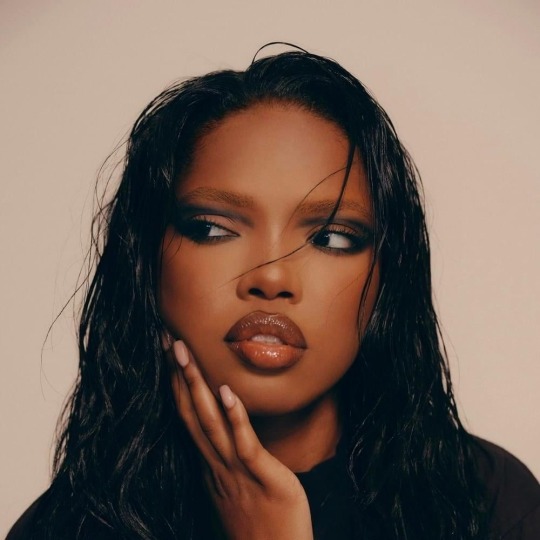


����Ketu Nakshatras (Magha, Ashwini, Mula)
-Ketu Nakshatras have the dark feminine vibe but more in a melancholic kind of way. Their femininity is more darker than mercurials and often dress in black or darker colors in general. they also have a very unbothered look to them. I notice that these ketuvians can be complex and very misunderstood, you think that you have them figured out but there is WAY more to them than beyond surface level. They have a haunting type of beauty! The kind of women you never forget.
Ex. Kat Dennings (Magha Moon), India Eisley (Ashwini Moon), Amy Winehouse (Mula Moon)



🌞 Sun Nakshatras (Uttara Ashada, Krittika, Uttara Phalguni)
-These hotties are bombshells. They have the ability to light up any room. They also have such a radiant aura as well. They are the "hard to get" hot girl that everyone pines over! They are usually center of attention no matter where they go. I notice that they are charismatic as well and that’s what honestly reels people in the most! In my opinion, they remind me so much of a trophy wife. Their partners love being able to tell people that you guys are married/dating.
Ex. Madelyn Cline (Uttara Phalguni ASC & Moon), Eliza Dushku (Krittika ASC), Naomi Campbell (Uttara Ashada ASC)



⚡️Rahu Nakshatras (Ardra, Swati, Shatabhisha)
-Have you heard of the quote from Scarface “The eyes, Chico. They never lie.”? Well that’s basically these nakshatras. Their eyes can tell stories and they can communicate to others very well with them. Often times they can look pretty sad even when they aren’t. Rahuvians look so dreamy, I can’t explain it, they look so soft but intense at the same time! Honestly, they are the type of girls people write about. Absolutely captivating!
Ex. Brittany Murphy (Swati Moon), Kaya Scodelario (Ardra Moon), Audrey Hepburn (Shatabhisha Moon)

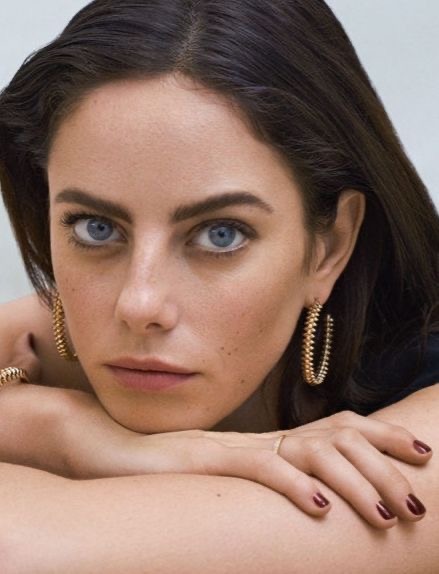

🛸 Saturn Nakshatras (Pushya, Anuradha, Uttara Bhadrapada)
-Otherworldly beauty! If you go outside you won’t see many people that look like them, their beauty cannot be replicated ever and trust me they will try to! These nakshatras were blessed with alluring and unique features. Saturnians look like they came right out of a fantasy film with different beautiful creations that are not of this world. They will also kill it in modeling especially editorial/high fashion they have the type of beauty that the modeling industry goes for.
Ex. Yara Shahidi (Anuradha ASC), Angelina Jolie (Pushya ASC), Halle Bailey (Uttara Bhadrapada Sun)


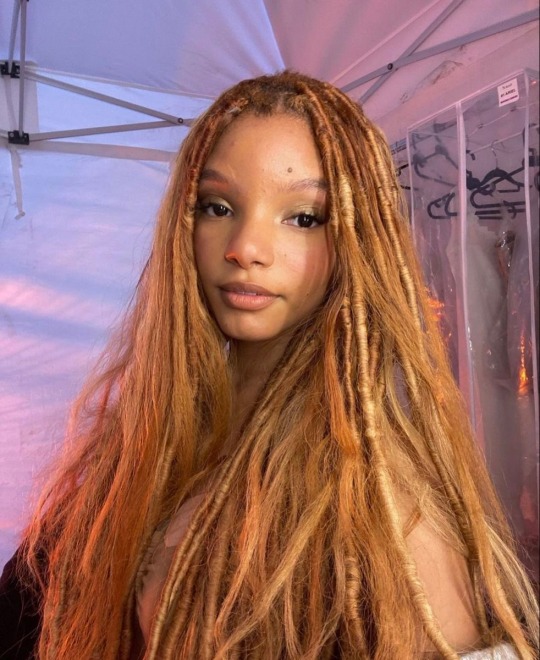
💋 Jupiter Nakshatras (Punarvasu, Vishakha, Purva Bhadrapada)
-These Nakshatras are MANEATERS! no but seriously they are so seductive! They can give office siren as well. I truly believe they can make anyone get down on their knees for them. Their aura to me is pretty powerful they know exactly how to act to get people (men especially) at their beck and call. I also notice that people lust after them quite often, they could easily use that for their personal gain if they wanted to.
Ex. Penelope Cruz (Punarvasu Moon), Lily Rose Depp (Vishakha ASC), Madison Beer (Purva Bhadrapada Sun)



Yours Truly,
divinefemmexx 🖤
#vedic astrology#astro notes#astro observations#nakshatra#sidereal astrology#astrology#vedic astro observations#vedic astro notes#purva phalguni#purva ashadha#purva bhadrapada#uttara ashadha#uttara phalguni#uttara bhadrapada#hasta nakshatra#bharani#pushya#shatabhisha#anuradha#ardra nakshatra#krittika#magha#ashwini#mula nakshatra#ashlesha#nakshatras#vedic notes#vedic astrology observations#rohini#shravana
1K notes
·
View notes
Text
𝓣𝓱𝓮 𝓨𝓸𝓷𝓲 𝓐𝓷𝓲𝓶𝓪𝓵𝓼 & 𝓣𝓱𝓮𝓲𝓻 𝓘𝓷𝓼𝓽𝓲𝓷𝓬𝓽𝓼

𝓐𝓼𝓱𝔀𝓲𝓷𝓲, 𝓢𝓱𝓪𝓽𝓪𝓫𝓱𝓲𝓼𝓱𝓪 🐎
ɪɴᴅᴇᴘᴇɴᴅᴇɴᴄᴇ ᴀɴᴅ ꜰʀᴇᴇᴅᴏᴍ ɪꜱ ʜɪɢʜʟʏ ᴠᴀʟᴜᴇᴅ ᴡɪᴛʜɪɴ ᴛʜᴇɪʀ ʟɪꜰᴇ, ᴛʜᴇʏ ᴅᴏɴ'ᴛ ʟɪᴋᴇ ᴛᴏ ʙᴇ ᴛɪᴇᴅ ᴅᴏᴡɴ ᴛᴏ ᴀɴʏᴛʜɪɴɢ ᴀɴᴅ ᴄᴀɴ ʙᴇ ᴄᴏᴍᴍɪᴛᴍᴇɴᴛ-ᴘʜᴏʙᴇꜱ. ᴍɪꜱᴄᴏᴍᴍᴜɴɪᴄᴀᴛɪᴏɴ ᴀɴᴅ ꜱʟᴏᴡ ᴀᴛ ᴘʀᴏᴄᴇꜱꜱɪɴɢ ɪɴꜰᴏʀᴍᴀᴛɪᴏɴ. ᴠᴇʀʏ ʟᴇᴀɴ ᴀɴᴅ ᴛᴀʟʟ ʙᴜɪʟᴅꜱ ᴡɪᴛʜ ʟᴏɴɢ ᴛʜɪᴄᴋ ʜᴀɪʀ. ᴍᴀᴊᴇꜱᴛɪᴄ ʙᴇᴀᴜᴛʏ. ᴡʜᴇɴ ᴛʜᴇʏ ᴡᴀʟᴋ, ᴛʜᴇɪʀ ꜰᴏᴏᴛꜱᴛᴇᴘꜱ ᴀʀᴇ ʜᴇᴀᴠʏ ᴀɴᴅ ᴘᴇᴏᴘʟᴇ ᴜꜱᴜᴀʟʟʏ ʜᴇᴀʀᴅ ᴛʜᴇᴍ ʙᴇꜰᴏʀᴇ ᴛʜᴇʏ ꜱᴇᴇ ᴛʜᴇᴍ.
ɪɴ ᴛᴇʀᴍꜱ ᴏꜰ ꜱᴇxᴜᴀʟ ʀᴇʟᴀᴛɪᴏɴꜱʜɪᴘꜱ, ᴛʜᴇʏ'ʀᴇ Qᴜɪᴛᴇ ᴅᴏᴍɪɴᴀɴᴛ ᴀɴᴅ ʟᴏᴠᴇ ʀɪᴅɪɴɢ ᴘᴏꜱɪᴛɪᴏɴꜱ (ᴍᴀʏ ᴋɴᴏᴡ ʜᴏᴡ ᴛᴏ ᴍᴏᴠᴇ ᴛʜᴇɪʀ ʜɪᴘꜱ ɪꜰʏᴡɪᴍ). ꜱᴇx ɪꜱ ʀᴏᴜɢʜ ᴀɴᴅ ɪɴᴛᴇɴꜱᴇ ʙᴜᴛ ꜰᴀꜱᴛ ᴀɴᴅ ɪꜱ ᴜꜱᴜᴀʟʟʏ ᴏᴠᴇʀ ᴘʀᴇᴛᴛʏ Qᴜɪᴄᴋʟʏ, ɴᴏᴛ ᴛʜᴇ ᴛʏᴘᴇ ᴛᴏ ʜᴀᴠᴇ ᴀ ʟᴏᴛ ᴏꜰ ꜱᴛᴀᴍɪɴᴀ.
𝓑𝓱𝓪𝓻𝓪𝓷𝓲, 𝓡𝓮𝓿𝓪𝓽𝓲 🐘
ᴠᴇʀʏ ꜱᴘɪʀɪᴛᴜᴀʟ ᴀɴᴅ ᴅɪꜱᴘʟᴀʏꜱ ᴀ Qᴜɪᴇᴛ ꜱᴛʀᴇɴɢᴛʜ. ᴛʜᴇʏ ᴅᴏɴ'ᴛ ʟɪᴋᴇ ʟᴏᴜᴅ ᴘᴇᴏᴘʟᴇ ᴏʀ ᴀɴʏᴛʜɪɴɢ ᴛʜᴀᴛ ᴄᴀɴ ᴅɪꜱᴛᴜʀʙ ᴛʜᴇɪʀ ᴘᴇᴀᴄᴇ ꜰᴏʀ ᴛʜᴀᴛ ᴀꜱ ᴛʜᴇʏ ʀᴇꜱᴘᴇᴄᴛ ʜᴜᴍɪʟɪᴛʏ ᴀɴᴅ ʜᴏɴᴇꜱᴛʏ. ᴀᴍᴀᴢɪɴɢ ᴍᴇᴍᴏʀʏ, ɪᴛ'ꜱ ᴀᴄᴛᴜᴀʟʟʏ ᴄʀᴀᴢʏ. ᴘʀᴏᴍɪɴᴇɴᴛ ᴇᴀʀꜱ ᴀɴᴅ ᴀ ꜱᴛᴜʀᴅʏ ʙᴏᴅʏ ᴡɪᴛʜ ᴀ ɢᴇɴᴛʟᴇ, ꜰᴏᴄᴜꜱᴇᴅ ɢᴀᴢᴇ.
ɪɴ ᴛᴇʀᴍꜱ ᴏꜰ ꜱᴇxᴜᴀʟ ʀᴇʟᴀᴛɪᴏɴꜱʜɪᴘꜱ, ᴛʜᴇʏ ᴄᴀɴ ʙᴇ ꜱᴇɴꜱᴜᴀʟ ᴀɴᴅ ᴘᴀᴛɪᴇɴᴛ ʙᴜᴛ ᴛʜᴇ ꜰᴇᴍᴀʟᴇ ᴇʟᴇᴘʜᴀɴᴛ ᴄᴀɴ ᴀᴄᴛ ᴀ ʙɪᴛ ᴄᴏʏ ʙᴇꜰᴏʀᴇ ᴅᴇᴄɪᴅɪɴɢ ᴛᴏ ꜰᴜʟʟʏ ᴇɴɢᴀɢᴇ ɪɴ ꜱᴇxᴜᴀʟ ᴀᴄᴛꜱ. ᴛʜᴇʏ ʜᴀᴠᴇ ᴀ ᴠᴇʀʏ ʜɪɢʜ ꜱᴇxᴜᴀʟ ᴀᴘᴘᴇᴛɪᴛᴇ ʙᴜᴛ ᴛʜᴇʏ ᴅᴇꜱɪʀᴇ ᴛᴏ ᴄᴏɴɴᴇᴄᴛ ᴛᴏ ᴛʜᴇɪʀ ᴘᴀʀᴛɴᴇʀꜱ ᴏɴ ᴀ ꜱᴏᴜʟ ʟᴇᴠᴇʟ. ᴛᴀɴᴛʀɪᴄ ꜱᴇx ᴡᴏᴜʟᴅ ʙᴇ ᴛʜᴇ ʙᴇꜱᴛ ᴡᴀʏ ᴛᴏ ᴇxᴘʟᴀɪɴ ɪᴛ.

𝓚𝓻𝓲𝓽𝓽𝓲𝓴𝓪, 𝓟𝓾𝓼𝓱𝔂𝓪 🐑
ᴠᴇʀʏ ꜱᴛᴏɪᴄ ᴀɴᴅ ʀᴇꜱᴇʀᴠᴇᴅ ᴜᴘᴏɴ ꜰɪʀꜱᴛ ɪᴍᴘʀᴇꜱꜱɪᴏɴ, ᴄᴀɴ ᴇᴠᴇɴ ᴄᴏᴍᴇ ᴏꜰꜰ ᴀꜱ ᴄᴏʟᴅ ᴇᴠᴇɴ ᴛʜᴏᴜɢʜ ᴛʜᴇʏ'ʀᴇ ᴇxᴛʀᴇᴍᴇʟʏ ꜱᴇɴꜱɪᴛɪᴠᴇ ᴀɴᴅ ᴄᴀʀɪɴɢ. ᴛʜᴇʏ ᴠᴀʟᴜᴇ ᴛʀᴀᴅɪᴛɪᴏɴꜱ ᴀɴᴅ ʀᴜʟᴇꜱ, ʙᴇʟɪᴇᴠɪɴɢ ᴛʜᴀᴛ ᴇᴠᴇʀʏᴏɴᴇ ʜᴀꜱ ᴀ ʀᴏʟᴇ ᴛᴏ ᴘʟᴀʏ. ꜱᴇʟꜰ-ᴄᴏɴꜱᴄɪᴏᴜꜱ ʙᴜᴛ ɴᴏᴛ ɪɴꜱᴇᴄᴜʀᴇ, ᴛʜᴇʏ'ʀᴇ ᴊᴜꜱᴛ ᴇxᴛʀᴇᴍᴇʟʏ ᴀᴡᴀʀᴇ ᴏꜰ ᴛʜᴇɪʀ ꜱᴇɴꜱᴇ ᴏꜰ ꜱᴇʟꜰ. ᴀɴᴅʀᴏɢʏɴᴏᴜꜱ ꜰᴇᴀᴛᴜʀᴇꜱ.
ɪɴ ᴛᴇʀᴍꜱ ᴏꜰ ꜱᴇxᴜᴀʟ ʀᴇʟᴀᴛɪᴏɴꜱʜɪᴘꜱ, ᴋʀɪᴛᴛɪᴋᴀ ɪꜱ ʟɪᴋᴇʟʏ ᴛᴏ ʙᴇ ᴀɢɢʀᴇꜱꜱɪᴠᴇʟʏ ꜱᴜʙᴍɪꜱꜱɪᴠᴇ ᴀɴᴅ ᴘᴜꜱʜʏᴀ ɪꜱ ᴍᴏʀᴇ ɢᴇɴᴛʟʏ ᴅᴏᴍɪɴᴀɴᴛ. ᴛʜᴇʏ ᴘʀᴇꜰᴇʀ ꜱᴇx ᴛᴏ ʙᴇ ᴀɴ ᴇᴠᴇɴ ᴍɪx ʙᴇᴛᴡᴇᴇɴ ʀᴏᴜɢʜ ᴀɴᴅ ꜱᴇɴꜱᴜᴀʟ. ɪɴᴛᴏ ʟᴇᴀᴠɪɴɢ ᴍᴀʀᴋꜱ ᴏɴ ᴛʜᴇɪʀ ᴘᴀʀᴛɴᴇʀꜱ ᴏʀ ʙᴇɪɴɢ ᴍᴀʀᴋᴇᴅ, ꜱᴄʀᴀᴛᴄʜɪɴɢ, ᴅɪɢɢɪɴɢ ᴛʜᴇɪʀ ɴᴀɪʟꜱ ɪɴᴛᴏ ʏᴏᴜʀ ꜱᴋɪɴ, ᴇᴛᴄ.
𝓡𝓸𝓱𝓲𝓷𝓲, 𝓜𝓻𝓲𝓰𝓪𝓼𝓱𝓲𝓻𝓼𝓱𝓪 🐍
ᴇxᴛʀᴇᴍᴇʟʏ ᴘʀɪᴠᴀᴛᴇ ᴀɴᴅ ꜱᴇɴꜱɪᴛɪᴠᴇ ᴛᴏ ᴛʜᴇ ᴇɴᴇʀɢɪᴇꜱ ᴀʀᴏᴜɴᴅ ᴛʜᴇᴍ. ᴛʜᴇʏ ᴇɴᴊᴏʏ ʟɪᴠɪɴɢ ᴄᴏᴍꜰᴏʀᴛᴀʙʟʏ ᴀɴᴅ ᴍᴀʏ ᴠᴀʟᴜᴇ ᴍᴀᴛᴇʀɪᴀʟ ᴛʜɪɴɢꜱ ᴛʜᴀᴛ ᴡᴏᴜʟᴅ ʙᴇ ꜱᴇᴇɴ ᴀꜱ ᴀᴇꜱᴛʜᴇᴛɪᴄᴀʟʟʏ ᴘʟᴇᴀꜱɪɴɢ. ʜᴀꜱ ᴀ ᴡᴀʏ ᴡɪᴛʜ ᴡᴏʀᴅꜱ ᴀɴᴅ ᴋɴᴏᴡꜱ ʜᴏᴡ ᴛᴏ ɢᴇᴛ ᴏᴜᴛ ᴏꜰ ꜱᴛɪᴄᴋʏ ꜱɪᴛᴜᴀᴛɪᴏɴꜱ ʙᴜᴛ ᴛʜᴇɪʀ ᴡᴏʀᴅꜱ ᴄᴀɴ ᴀʟꜱᴏ ɢᴇᴛ ᴛʜᴇᴍ ɪɴ ᴛʀᴏᴜʙʟᴇ. ᴠᴇʀʏ ꜰʟɪʀᴛᴀᴛɪᴏᴜꜱ ᴀɴᴅ ɪɴᴛᴏxɪᴄᴀᴛɪɴɢ. ʙᴇᴀᴜᴛɪꜰᴜʟ ᴇʏᴇꜱ ᴀɴᴅ ᴅᴇʟɪᴄᴀᴛᴇ ꜰɪɢᴜʀᴇ.
ɪɴ ᴛᴇʀᴍꜱ ᴏꜰ ꜱᴇxᴜᴀʟ ʀᴇʟᴀᴛɪᴏɴꜱʜɪᴘꜱ, ᴛʜᴇʏ ᴀʀᴇ ᴘʜʏꜱɪᴄᴀʟʟʏ ꜱᴇɴꜱɪᴛɪᴠᴇ ᴀɴᴅ ʜᴀᴛᴇꜱ ᴡʜᴇɴ ᴛʜɪɴɢꜱ ꜰᴇᴇʟ ʀᴜꜱʜᴇᴅ. ᴛʜᴇʏ ᴀʀᴇ ʜᴇᴀᴠɪʟʏ ɪɴᴛᴏ ꜰᴏʀᴇᴘʟᴀʏ ᴡʜᴇʀᴇ ᴛʜᴇʏ ᴄᴀɴ ᴇɴɢᴀɢᴇ ᴛʜᴇɪʀ ꜱᴇɴꜱᴇꜱ ᴀꜱ ᴛʜᴇʏ ᴡᴀɴᴛ ᴛᴏ ꜰᴇᴇʟ ᴇᴠᴇʀʏ ɪɴᴄʜ ᴏꜰ ᴛʜᴇɪʀ ᴘᴀʀᴛɴᴇʀ ᴀɢᴀɪɴꜱᴛ ᴛʜᴇᴍ. ʀᴏᴘᴇ ʙᴜɴɴʏ ᴋɪɴᴋ. ᴡᴏᴜʟᴅ ᴘʀᴏʙᴀʙʟʏ ᴡʀᴀᴘ ᴛʜᴇɪʀ ᴀʀᴍꜱ ᴀɴᴅ ʟᴇɢꜱ ᴛɪɢʜᴛʟʏ ᴀʀᴏᴜɴᴅ ᴛʜᴇɪʀ ᴘᴀʀᴛɴᴇʀ. ᴏɴᴇ ᴏꜰ ᴛʜᴇ ɴᴀᴋꜱʜᴀᴛʀᴀꜱ ᴛᴏ ᴇɴɢᴀɢᴇ ɪɴ ʙᴅꜱᴍ (ʀᴏʜɪɴɪ ɪꜱ ᴍᴏʀᴇ ʟɪᴋᴇʟʏ) ᴏʀ ᴀɴʏ ᴏᴛʜᴇʀ ꜱᴇxᴜᴀʟ ᴀᴄᴛɪᴠɪᴛʏ ᴛʜᴀᴛ ᴅᴏᴇꜱɴ'ᴛ ɪɴᴠᴏʟᴠᴇ ᴘʜʏꜱɪᴄᴀʟ ᴄᴏɴᴛᴀᴄᴛ ᴀᴛ ᴀʟʟ.

𝓐𝓻𝓭𝓻𝓪, 𝓜𝓾𝓵𝓪 🐕
ʟᴏʏᴀʟ ᴀɴᴅ ᴇᴍᴏᴛɪᴏɴᴀʟ ɪɴᴅɪᴠɪᴅᴜᴀʟꜱ, ᴄᴀɴ ꜱᴏᴍᴇᴛɪᴍᴇꜱ ᴄᴏᴍᴇ ᴏꜰꜰ ᴀ ʙɪᴛ ᴛᴏᴏ ɪɴᴛᴇɴꜱᴇ. ᴛʜᴇʏ ᴄᴀɴ ʙᴇ Qᴜɪᴛᴇ ᴄᴀɴᴅɪᴅ ᴀɴᴅ ᴡᴏɴ'ᴛ ꜱᴜɢᴇʀᴄᴏᴀᴛ ᴀɴʏᴛʜɪɴɢ ᴛᴏ ᴍᴀᴋᴇ ʏᴏᴜ ꜰᴇᴇʟ ʙᴇᴛᴛᴇʀ, ᴛʜᴇʏ ᴛᴇʟʟ ɪᴛ ʟɪᴋᴇ ɪᴛ ɪꜱ. ᴘʀᴏᴛᴇᴄᴛɪᴠᴇ ᴛᴏᴡᴀʀᴅꜱ ᴛʜᴏꜱᴇ ᴛʜᴇʏ ʟᴏᴠᴇ ᴀɴᴅ ᴡᴏɴ'ᴛ ʜᴇꜱɪᴛᴀᴛᴇ ᴛᴏ ᴛᴀᴋᴇ ᴀ ʙᴜʟʟᴇᴛ ꜰᴏʀ ᴛʜᴇ ᴏɴᴇꜱ ᴛʜᴇʏ ᴄᴀʀᴇ ꜰᴏʀ. ᴛʜᴇʏ ᴄᴀɴ ʙᴇᴄᴏᴍᴇ ʀᴜᴛʜʟᴇꜱꜱ ᴀɴᴅ ᴄᴏʟᴅ ɪꜰ ʙᴇᴛʀᴀʏᴇᴅ ɪɴ ᴀɴʏ ᴡᴀʏ. ᴡɪʟᴅ ʜᴀɪʀ ᴀɴᴅ ꜱᴛʀɪᴋɪɴɢ ᴇʏᴇꜱ. ʙᴇɪɴɢ ɪɴ ᴀ ꜰᴏʀᴇꜱᴛ ᴏʀ ꜱᴜʀʀᴏᴜɴᴅᴇᴅ ʙʏ ɴᴀᴛᴜʀᴇ ᴍᴀᴋᴇꜱ ᴛʜᴇᴍ ꜰᴇᴇʟ ᴀᴛ ᴇᴀꜱᴇ. ʟɪᴋᴇʟʏ ᴛᴏ ʟɪᴠᴇ ɪɴ ʀᴜʀᴀʟ ᴄᴏᴍᴍᴜɴɪᴛɪᴇꜱ ᴏʀ ʜᴏᴜꜱᴇꜱ ɴᴇᴀʀ ᴡᴏᴏᴅꜱ.
ɪɴ ᴛᴇʀᴍꜱ ᴏꜰ ꜱᴇxᴜᴀʟ ʀᴇʟᴀᴛɪᴏɴꜱʜɪᴘꜱ, ᴛʜᴇʏ ᴀʀᴇ ᴀʟʟ ᴀʙᴏᴜᴛ ᴇᴍᴏᴛɪᴏɴᴀʟʟʏ ʙᴏɴᴅɪɴɢ ᴡɪᴛʜ ᴛʜᴇɪʀ ᴘᴀʀᴛɴᴇʀꜱ ᴀɴᴅ ᴡɪʟʟ ʙᴇᴄᴏᴍᴇ Qᴜɪᴛᴇ ᴄʟɪɴɢʏ ᴀꜰᴛᴇʀ ꜱᴇx, ᴛʜᴇ ᴛʏᴘᴇꜱ ᴛᴏ ᴄᴜᴅᴅʟᴇ ᴀꜰᴛᴇʀᴡᴀʀᴅꜱ. ɪꜰ ᴛʜᴇɪʀ ᴘᴀʀᴛɴᴇʀ ɪꜱɴ'ᴛ ᴏɴ ᴘᴀʀ ᴡɪᴛʜ ᴛʜᴇɪʀ ᴇɴᴇʀɢʏ, ᴛʜᴇʏ ᴄᴀɴ ʙᴇᴄᴏᴍᴇ ᴀɢɪᴛᴀᴛᴇᴅ. ᴠᴇʀʏ ʟᴏᴠɪɴɢ ᴀɴᴅ ᴘᴀꜱꜱɪᴏɴᴀᴛᴇ ɪɴ ʙᴇᴅ.
𝓟𝓾𝓷𝓪𝓻𝓿𝓪𝓼𝓾, 𝓐𝓼𝓱𝓵𝓮𝓼𝓱𝓪 🐈⬛
ʟᴀɴɢᴜɪᴅ ᴀɴᴅ ꜰɪɴɴɪᴄᴋʏ, ᴛʜᴇʏ ᴀʀᴇ ᴠᴇʀʏ ᴘᴀʀᴛɪᴄᴜʟᴀʀ ᴀʙᴏᴜᴛ ᴡʜᴏ ʟᴇᴛ ᴀʀᴏᴜɴᴅ ᴛʜᴇᴍ ꜱɪɴᴄᴇ ᴛʜᴇʏ ᴄᴀɴ ᴇᴀꜱɪʟʏ ꜰᴇᴇʟ ᴅɪꜱᴛᴜʀʙᴇᴅ. ᴘʀᴇᴛᴛʏ ᴍᴏ��ᴅʏ ꜱᴏ ᴛʜᴇʏ ᴄᴀɴ ʙᴇ ᴠᴇʀʏ ᴄʟɪɴɢʏ ᴀɴᴅ ᴀꜰꜰᴇᴄᴛɪᴏɴᴀᴛᴇ ᴏɴᴇ ᴍɪɴᴜᴛᴇ ᴏʀ ꜱᴀꜱꜱʏ ᴀɴᴅ ᴀɴɴᴏʏᴇᴅ ᴛʜᴇ ɴᴇxᴛ ᴍɪɴᴜᴛᴇ. ᴄᴀɴ ᴀᴘᴘᴇᴀʀ ɪɴɴᴏᴄᴇɴᴛ ʏᴇᴛ ᴋɴᴏᴡꜱ ᴍᴏʀᴇ ᴛʜᴀɴ ʏᴏᴜ ᴛʜɪɴᴋ ᴀɴᴅ ꜱᴜʙᴛʟʏ ᴍᴀɴɪᴘᴜʟᴀᴛɪᴠᴇ. ᴀʟᴍᴏɴᴅ-ꜱʜᴀᴘᴇᴅ ᴇʏᴇꜱ, ꜱʟɪᴍ ɴᴏꜱᴇ, ᴀɴᴅ ꜱᴍᴀʟʟ ʟɪᴘꜱ ᴛʜᴀᴛ'ꜱ ꜰᴇʟɪɴᴇ ᴀɴᴅ ᴅᴀɪɴᴛʏ ɪɴ ᴀᴘᴘᴇᴀʀᴀɴᴄᴇ.
ɪɴ ᴛᴇʀᴍꜱ ᴏꜰ ꜱᴇxᴜᴀʟ ʀᴇʟᴀᴛɪᴏɴꜱʜɪᴘꜱ, ᴛʜᴇʏ ᴡᴀɴᴛ ᴀ ᴘᴀʀᴛɴᴇʀ ᴡʜᴏ'ꜱ ᴠᴇʀʏ ᴄᴀʀᴇꜰᴜʟ ᴡɪᴛʜ ᴛʜᴇᴍ ꜱɪɴᴄᴇ ᴀɴʏ ʟɪᴛᴛʟᴇ ᴛʜɪɴɢ ᴄᴀɴ ꜱᴇᴛ ᴛʜᴇᴍ ᴏꜰꜰ. ᴀꜱʜʟᴇꜱʜᴀ ᴍᴀʏ ʜᴀᴠᴇ ᴀ ᴍᴏʀᴇ ʜᴀʀᴅᴇʀ ᴛɪᴍᴇ ꜱɪɴᴄᴇ ᴛʜᴇʏ ᴍᴀʏ ʜᴀᴠᴇ ɪꜱꜱᴜᴇꜱ ʀᴇɢᴀʀᴅɪɴɢ ᴛʜᴇɪʀ ꜱᴇxᴜᴀʟɪᴛʏ (ᴛʜᴇ ᴍᴀʟᴇ ᴄᴀᴛ ʜᴀᴠɪɴɢ ᴀ ʙᴀʀʙᴇᴅ ᴘ*ɴɪꜱ). ᴛʜᴇʏ ᴍᴀʏ ᴀʟꜱᴏ ᴅᴇꜱɪʀᴇ ꜰᴏʀᴇᴘʟᴀʏ ᴀɴᴅ ʟɪᴋᴇᴅ ᴛᴏ ʙᴇ ᴄʜᴏᴋᴇᴅ. ᴘᴜɴᴀʀᴠᴀꜱᴜ ɪꜱ ᴛʜᴇ ʙʀᴀᴛᴛʏ ꜱᴜʙᴍɪꜱꜱɪᴠᴇ ᴡʜɪʟᴇ ᴀꜱʜʟᴇꜱʜᴀ ɪꜱ ᴛʜᴇ ꜱᴛᴀɴᴅᴀʀᴅ ᴅᴏᴍɪɴᴀɴᴛ.

𝓜𝓪𝓰𝓱𝓪, 𝓟𝓾𝓻𝓿𝓪 𝓟𝓱𝓪𝓵𝓰𝓾𝓷𝓲 🐀
ꜱᴇxᴜᴀʟʟʏ ᴠᴏʀᴀᴄɪᴏᴜꜱ ᴀɴᴅ ꜱᴏᴄɪᴀʙʟᴇ ɪɴᴅɪᴠɪᴅᴜᴀʟꜱ. ᴠᴇʀʏ ꜱᴇʟꜰ-ᴄᴇɴᴛᴇʀᴇᴅ ʙᴜᴛ ɴᴇᴠᴇʀ ᴜɴᴄᴀʀɪɴɢ, ᴛʜᴇʏ ᴊᴜꜱᴛ ʜᴀᴠᴇ ꜱᴛʀᴏɴɢ ᴇɢᴏꜱ ᴀɴᴅ ᴀ ꜱᴇɴꜱᴇ ᴏꜰ ᴘʀɪᴅᴇ. ʜᴀꜱ ᴘʀᴏʙᴀʙʟʏ ꜱᴛᴏʟᴇɴ ꜱᴏᴍᴇᴛʜɪɴɢ ʙᴇꜰᴏʀᴇ ᴀɴᴅ ɢᴏᴛᴛᴇɴ ᴀᴡᴀʏ ᴡɪᴛʜ ɪᴛ. ᴛʜᴇʏ ᴛᴀᴋᴇ ᴄᴀʀᴇ ɪɴ ᴛᴇɴᴅɪɴɢ ᴛᴏ ᴛʜᴇɪʀ ᴀᴘᴘᴇᴀʀᴀɴᴄᴇ ᴀɴᴅ ᴀʟᴡᴀʏꜱ ʀᴇᴍᴀɪɴɪɴɢ ᴘʀᴇꜱᴇɴᴛᴀʙʟᴇ. ᴀᴘᴘᴇᴀʀꜱ ᴇᴍᴏᴛɪᴏɴʟᴇꜱꜱ ᴏɴ ᴛʜᴇ ᴏᴜᴛꜱɪᴅᴇ. ʙɪɢ ʜᴀɪʀ ᴀɴᴅ ᴀ ʜᴀᴜɢʜᴛʏ ɪᴍᴘʀᴇꜱꜱɪᴏɴ, ᴇꜰꜰᴏʀᴛʟᴇꜱꜱʟʏ ᴀᴛᴛʀᴀᴄᴛꜱ ᴀᴛᴛᴇɴᴛɪᴏɴ.
ɪɴ ᴛᴇʀᴍꜱ ᴏꜰ ꜱᴇxᴜᴀʟ ʀᴇʟᴀᴛɪᴏɴꜱʜɪᴘꜱ, ᴛʜᴇʏ ᴀʀᴇ ɴᴀᴛᴜʀᴀʟʟʏ ᴅᴏᴍɪɴᴀɴᴛ ᴀɴᴅ ᴀʀᴇɴ'ᴛ ᴀꜰʀᴀɪᴅ ᴛᴏ ᴛʀʏ ᴀɴʏᴛʜɪɴɢ ꜱᴇxᴜᴀʟʟʏ ᴛᴀʙᴏᴏ. ᴛʜᴇʏ ʜᴀᴠᴇ ᴛʜᴇ ᴄʀᴀᴢɪᴇꜱᴛ ꜱᴇxᴜᴀʟ ᴋɪɴᴋꜱ, ɪᴛ'ꜱ ʟᴏᴡ-ᴋᴇʏ ᴄᴏɴᴄᴇʀɴɪɴɢ. ᴇɴᴅʟᴇꜱꜱ ꜱᴛᴀᴍɪɴᴀ ᴀɴᴅ ꜱʜᴀᴍᴇʟᴇꜱꜱ ɪɴ ʙᴇʜᴀᴠɪᴏʀ. ᴍᴀʏ ʜᴀᴠᴇ ᴀ ᴘʀᴀɪꜱᴇ ᴋɪɴᴋ ꜱɪɴᴄᴇ ᴀᴛᴛᴇɴᴛɪᴏɴ ᴛɪᴄᴋʟᴇꜱ ᴛʜᴇɪʀ ꜱᴏᴜʟ.
𝓤𝓽𝓽𝓪𝓻𝓪 𝓟𝓱𝓪𝓵𝓰𝓾𝓷𝓲, 𝓤𝓽𝓽𝓪𝓻𝓪 𝓑𝓱𝓪𝓭𝓻𝓪𝓹𝓪𝓭𝓪 🐄
ᴇxᴛʀᴇᴍᴇʟʏ ᴘᴀᴛɪᴇɴᴛ ᴀɴᴅ ᴄᴏɴꜱɪꜱᴛᴇɴᴛ, ɴᴏᴛ ᴛʜᴇ ᴛʏᴘᴇꜱ ᴛᴏ ʀᴜꜱʜ ɪɴᴛᴏ ᴀɴʏᴛʜɪɴɢ ᴀɴᴅ ᴘʀᴇꜰᴇʀ ᴛᴏ ᴡᴀɪᴛ ᴜɴᴛɪʟ ᴛʜᴀᴛ ᴍᴏᴍᴇɴᴛ ᴀʀɪꜱᴇꜱ ᴀᴛ ᴛʜᴇ ʀɪɢʜᴛ ᴍᴏᴍᴇɴᴛ. ᴘʀᴏʙᴀʙʟʏ ʟᴏᴠᴇꜱ ᴛᴏ ᴅʀɪɴᴋ ᴍɪʟᴋ ᴀɴᴅ ᴀʀᴇ ᴠᴇʀʏ ꜰᴇʀᴛɪʟᴇ. ꜱᴇᴇɴ ᴀꜱ ʀᴇʟɪᴀʙʟᴇ ᴀɴᴅ ᴘᴇʀꜰᴇᴄᴛ ꜱɪɴᴄᴇ ᴀʟʟ ᴛʜᴇɪʀ ᴇᴍᴏᴛɪᴏɴꜱ ᴀʀᴇ ᴍᴏʀᴇ ��ɴᴛᴇʀɴᴀʟ, ᴄᴀɴ ʜᴀᴠᴇ ᴀ ʀᴇꜱᴛɪɴɢ ʙʟᴀɴᴋ ꜰᴀᴄᴇ. ᴅɪꜰꜰɪᴄᴜʟᴛ ᴛᴏ ʀᴇᴀᴅ ɪɴ ɢᴇɴᴇʀᴀʟ. ꜱQᴜᴀʀɪꜱʜ ꜰᴀᴄᴇ ᴀɴᴅ ꜱᴛᴇᴀᴅʏ ɢᴀᴢᴇ, ᴡᴇʟʟ-ꜰᴏʀᴍᴇᴅ ʙᴏᴅɪᴇꜱ.
ɪɴ ᴛᴇʀᴍꜱ ᴏꜰ ꜱᴇxᴜᴀʟ ʀᴇʟᴀᴛɪᴏɴꜱʜɪᴘꜱ, ᴛʜᴇʏ ᴄᴀɴ ᴇᴀꜱɪʟʏ ɢᴇᴛ ᴘʀᴇɢɴᴀɴᴛ (ꜰᴏʀ ᴍᴇɴ, ᴛʜᴇɪʀ ʟᴏᴀᴅꜱ ᴀʀᴇ ʜᴇᴀᴠʏ) ᴀɴᴅ ᴀʀᴇ ᴍᴏꜱᴛ ʟɪᴋᴇʟʏ ᴛᴏ ʜᴀᴠᴇ ᴍᴜʟᴛɪᴘʟᴇ ᴋɪᴅꜱ. ᴛʜᴇʏ ᴘʀᴇꜰᴇʀ ᴛᴏ ᴛᴀᴋᴇ ᴛʜᴇɪʀ ᴛɪᴍᴇ ʙᴜᴛ ᴡᴏɴ'ᴛ ɢᴇᴛ ᴍᴀᴅ ɪꜰ ᴛʜᴇʏ ᴡᴇʀᴇ ᴘᴜꜱʜᴇᴅ ɪɴᴛᴏ ꜱᴘᴇᴇᴅɪɴɢ ᴛʜɪɴɢꜱ ᴜᴘ. ᴍᴀʏ ʟᴏᴠᴇ ᴛᴏ ᴘʟᴀʏ ᴡɪᴛʜ ᴛʜᴇ ᴄʜᴇꜱᴛ ᴀʀᴇᴀ. ᴍᴏꜱᴛ ʟɪᴋᴇʟʏ ᴀʀᴇ ᴠᴇʀʏ ᴠᴀɴɪʟʟᴀ ᴀɴᴅ ꜱɪᴍᴘʟᴇ-ᴍɪɴᴅᴇᴅ.
𝓗𝓪𝓼𝓽𝓪, 𝓢𝔀𝓪𝓽𝓲 🐂
ᴛʜᴇ ꜰɪʀꜱᴛ ᴛʜɪɴɢ ɪꜱ ᴛʜᴀᴛ ᴛʜᴇʏ ᴀʀᴇ ᴠᴇʀʏ ꜱᴛᴜʙʙᴏʀɴ ʙᴜᴛ, ɪꜰ ʏᴏᴜ ᴘᴜꜱʜ ᴛʜᴇɪʀ ʙᴜᴛᴛᴏɴꜱ ᴇɴᴏᴜɢʜ, ᴛʜᴇʏ ᴄᴀɴ ɢᴇᴛ ᴇxᴛʀᴇᴍᴇʟʏ ʀᴏᴡᴅʏ ᴀɴᴅ ᴠɪᴏʟᴇɴᴛ. ᴛʜᴇɪʀ ᴀɴɢᴇʀ ɪꜱ ɴᴏ ᴊᴏᴋᴇ. ᴏɴ ᴛʜᴇ ᴏᴛʜᴇʀ ʜᴀɴᴅ, ᴛʜᴇʏ'ʀᴇ ᴠᴇʀʏ ʀᴇꜱɪʟɪᴇɴᴛ ᴀɴᴅ ᴠᴀʟᴜᴇ ᴘᴇʀꜱᴇᴠᴇʀᴀɴᴄᴇ ꜱɪɴᴄᴇ ᴛʜᴇʏ ʟᴏᴠᴇ ᴛᴏ ᴘᴜꜱʜ ᴛʜᴇᴍꜱᴇʟᴠᴇꜱ ᴛᴏ ᴅᴏ ʙᴇᴛᴛᴇʀ. ᴡᴀᴛᴇʀ ʀᴇᴘʟᴇɴɪꜱʜᴇꜱ ᴛʜᴇᴍ, ᴛʜᴇʏ ᴅᴏɴ'ᴛ ᴄᴀʀᴇ ꜰᴏʀ ꜱᴡᴇᴇᴛꜱ. ꜱᴛʀᴏɴɢ ᴀɴᴅ ʙᴏʟᴅ ꜰᴇᴀᴛᴜʀᴇꜱ ᴡɪᴛʜ ᴏᴘᴇɴ ᴇʏᴇꜱ.
ɪɴ ᴛᴇʀᴍꜱ ᴏꜰ ꜱᴇxᴜᴀʟ ʀᴇʟᴀᴛɪᴏɴꜱʜɪᴘꜱ, ᴛʜᴇʏ'ʀᴇ ᴠᴇʀʏ ᴀɢɢʀᴇꜱꜱɪᴠᴇ ᴀɴᴅ ᴡɪʟʟ ᴄᴏɴꜱɪꜱᴛᴇɴᴛʟʏ ᴘᴜꜱʜ ᴛʜᴇɪʀ ᴘᴀʀᴛɴᴇʀ ᴜɴᴛɪʟ ᴛʜᴇʏ ꜰɪɴᴀʟʟʏ ɢɪᴠᴇ ɪɴ ᴛᴏ ᴛʜᴇɪʀ ꜱᴇxᴜᴀʟ ᴀᴅᴠᴀɴᴄᴇꜱ ʙᴜᴛ ᴛʜᴇʏ ʜᴀᴠᴇ ᴛʜᴇ ᴀʙɪʟɪᴛʏ ᴛᴏ ʙᴇ ᴘᴀᴛɪᴇɴᴛ. ᴛʜᴇʏ ᴍᴀʏ ɴᴏᴛ ʟɪᴋᴇ ᴘᴇᴏᴘʟᴇ ᴡʜᴏ ᴅᴏɴ'ᴛ ᴋɴᴏᴡ ᴡʜᴀᴛ ᴛʜᴇʏ ᴡᴀɴᴛ, ɪᴛ ɪʀʀɪᴛᴀᴛᴇꜱ ᴛʜᴇᴍ. ꜱᴀᴅɪꜱᴛɪᴄ ᴅᴏᴍꜱ.

𝓒𝓱𝓲𝓽𝓻𝓪, 𝓥𝓲𝓼𝓱𝓪𝓴𝓪 🐅
ᴏᴜᴛᴡᴀʀᴅʟʏ ᴄᴏɴꜰɪᴅᴇɴᴛ, ɪɴᴡᴀʀᴅʟʏ ɪɴꜱᴇᴄᴜʀᴇ. ꜱᴛʀᴏɴɢ ᴘʀᴇꜱᴇɴᴄᴇ. ᴛʜᴇʏ ʟɪᴋᴇ ᴛᴏ ᴍᴀɪɴᴛᴀɪɴ ᴀ ꜱᴇɴꜱᴇ ᴏꜰ ᴄᴏɴᴛʀᴏʟ ᴀʀᴏᴜɴᴅ ᴛʜᴇɪʀ ᴇɴᴠɪʀᴏɴᴍᴇɴᴛ, ɪᴛ ᴋᴇᴇᴘꜱ ᴛʜᴇᴍ ꜱᴀɴᴇ. ᴠᴇʀʏ ꜰᴀꜱʜɪᴏɴᴀʙʟᴇ ᴀɴᴅ ʟᴏᴠᴇꜱ ᴊᴇᴡᴇʟʀʏ ᴏʀ ᴏᴛʜᴇʀ ᴀᴄᴄᴇꜱꜱᴏʀɪᴇꜱ. ᴛʜᴇʏ ᴄᴀʀᴇ ᴀ ʟᴏᴛ ᴀʙᴏᴜᴛ ᴛʜᴇ ᴏᴘɪɴɪᴏɴꜱ ᴏꜰ ᴏᴛʜᴇʀꜱ ᴀɴᴅ ᴄᴀɴ ʜᴀᴠᴇ ꜰᴏᴏᴛ-ɪɴ-ᴍᴏᴜᴛʜ ᴅɪꜱᴇᴀꜱᴇ. ꜱʟɪɢʜᴛʟʏ ᴡɪʟᴅ ʜᴀɪʀ ᴀɴᴅ ꜰɪᴇʀᴄᴇ ɢᴀᴢᴇ, ᴘʀᴇᴛᴛʏ ꜱᴍɪʟᴇ.
ɪɴ ᴛᴇʀᴍꜱ ᴏꜰ ꜱᴇxᴜᴀʟ ʀᴇʟᴀᴛɪᴏɴꜱʜɪᴘꜱ, ᴛʜᴇʏ ᴀʀᴇ ᴛʜᴇ ᴛʏᴘᴇꜱ ᴛᴏ ʀᴇᴀʟʟʏ ʀᴏᴄᴋ ʏᴏᴜʀ ᴡᴏʀʟᴅ (ɪꜰ ʏᴋ ʏᴋ). ᴡᴏᴜʟᴅ ʙᴇ ᴛʜᴇ ᴛʏᴘᴇꜱ ᴛᴏ ᴡʀᴇꜱᴛʟᴇ ʏᴏᴜ ɪɴᴛᴏ ꜱᴜʙᴍɪꜱꜱɪᴏɴ ɪꜰ ᴛʜᴇɪʀ ᴘᴀʀᴛɴᴇʀ ᴇᴠᴇʀ ꜱᴛᴇᴘꜱ ᴏᴜᴛ ᴏꜰ ʟɪɴᴇ (ꜰᴏʀ ᴛʜᴇ ᴡᴏᴍᴇɴ, ɪᴛ'ꜱ ᴛʜᴇ ᴏᴘᴘᴏꜱɪᴛᴇ). ᴘʀᴏʙᴀʙʟʏ ᴀʀᴇ ᴛʜᴇ ᴏɴᴇꜱ ɪɴᴛᴏ ʙᴇɪɴɢ ᴄᴀʟʟᴇᴅ ᴅᴀᴅᴅʏ/ᴍᴏᴍᴍʏ, ɪᴛ ʀᴇᴀʟʟʏ ꜰᴇᴇᴅꜱ ɪɴᴛᴏ ᴛʜᴇ ᴄᴏɴᴛʀᴏʟʟɪɴɢ, ᴅᴏᴍɪɴᴀɴᴛ ᴀꜱᴘᴇᴄᴛ ᴏꜰ ᴛʜᴇᴍ. ᴘʀᴏɴᴇ ᴛᴏ ʙᴇᴄᴏᴍᴇ ��ʜᴇᴀᴛᴇʀꜱ, ꜱᴇxᴜᴀʟʟʏ ɪɴᴛᴇɴꜱᴇ.
𝓐𝓷𝓾𝓻𝓪𝓭𝓱𝓪, 𝓙𝔂𝓮𝓼𝓽𝓱𝓪 🦌
ᴇɴᴠɪʀᴏɴᴍᴇɴᴛᴀʟʟʏ ᴀᴡᴀʀᴇ, ꜱᴏᴄɪᴀʟʟʏ ᴜɴᴀᴡᴀʀᴇ. ᴄᴀɴ ꜰɪɴᴅ ᴛʜᴇᴍꜱᴇʟᴠᴇꜱ ɪɴ ꜱɪᴛᴜᴀᴛɪᴏɴꜱ ᴡʜᴇʀᴇ ᴛʜᴇʏ ᴀʀᴇ ᴏꜰᴛᴇɴ ᴜꜱᴇᴅ ɪɴ ꜱᴏᴍᴇ ᴡᴀʏ ʙᴇᴄᴀᴜꜱᴇ ᴛʜᴇʏ'ʀᴇ ꜱᴏ ɢɪᴠɪɴɢ. ɴᴀᴛᴜʀᴀʟʟʏ ɢᴇɴᴛʟᴇ, ɴᴏ ᴍᴀᴛᴛᴇʀ ʜᴏᴡ ɪɴᴛɪᴍɪᴅᴀᴛɪɴɢ ᴛʜᴇʏ ᴍᴀʏ ᴀᴘᴘᴇᴀʀ. ᴀʟᴡᴀʏꜱ ꜰᴇᴇʟꜱ ᴛʜᴇ ɴᴇᴇᴅ ᴛᴏ ʙᴇ ᴏɴ ɢᴜᴀʀᴅ ᴀʟʟ ᴛʜᴇ ᴛɪᴍᴇ. ᴇᴍᴏᴛɪᴏɴᴀʟʟʏ ꜱᴇɴꜱɪᴛɪᴠᴇ ᴀɴᴅ ᴘᴜᴛꜱ ᴍᴜʟᴛɪᴘʟᴇ ᴡᴀʟʟꜱ ᴜᴘ, ᴍᴀᴋɪɴɢ ᴛʜᴇᴍ ᴅɪꜰꜰɪᴄᴜʟᴛ ᴛᴏ ɢᴇᴛ ᴛᴏ ᴋɴᴏᴡ ꜱɪɴᴄᴇ ᴛʜᴇʏ'ʀᴇ ᴘʀᴇᴛᴛʏ ᴠᴀɢᴜᴇ. ꜱʟᴇɴᴅᴇʀ ꜰᴀᴄᴇꜱ ᴀɴᴅ ᴅᴏᴇ ᴇʏᴇꜱ. ꜱᴏᴍᴇᴛʜɪɴɢ ᴀʙᴏᴜᴛ ᴛʜᴇᴍ ᴍᴀᴋᴇꜱ ʏᴏᴜ ᴡᴀɴᴛ ᴛᴏ ᴄʜᴀꜱᴇ ᴀꜰᴛᴇʀ ᴛʜᴇᴍ, ɪᴛ'ꜱ ᴋɪɴᴅ ᴏꜰ ꜱᴄᴀʀʏ ʜᴏᴡ ᴍᴜᴄʜ ᴘᴏᴡᴇʀ ᴛʜᴇʏ ʜᴀᴠᴇ. ᴘʀᴇᴛᴛʏ Qᴜɪᴇᴛ ᴀɴᴅ ᴏʙꜱᴇʀᴠᴀɴᴛ.
ꜱᴇxᴜᴀʟʟʏ, ᴛʜᴇʏ ᴘᴜᴛ ᴀʟʟ ᴛʜᴇɪʀ ᴇᴍᴏᴛɪᴏɴꜱ ꜰᴏʀᴡᴀʀᴅ ᴡʜɪᴄʜ ᴄᴀɴ ʙᴇ Qᴜɪᴛᴇ ᴏᴠᴇʀᴡʜᴇʟᴍɪɴɢ. ᴍᴏʀᴇ ᴀɢɢʀᴇꜱꜱɪᴠᴇ ᴘᴇʀꜱᴏɴᴀʟɪᴛɪᴇꜱ ᴄᴀɴ ᴏᴠᴇʀᴡʜᴇʟᴍ ᴛʜᴇᴍ ᴛʜᴏᴜɢʜ ʙᴜᴛ ᴛʜᴇʏ ᴡᴏɴ'ᴛ ʙᴇ ꜱᴏ Qᴜɪᴄᴋ ᴛᴏ ʀᴜɴ ᴀᴡᴀʏ ɪꜰ ɪᴛ'ꜱ ᴛʜᴇɪʀ ᴘᴀʀᴛɴᴇʀ. ꜱᴇxᴜᴀʟʟʏ ᴇxᴘʟᴏʀᴀᴛɪᴠᴇ. ʙᴇɪɴɢ ꜱᴜʙᴍɪꜱꜱɪᴠᴇ ᴛᴏ ᴛʜᴇɪʀ ᴘᴀʀᴛɴᴇʀ ꜱᴏᴍᴇʜᴏᴡ ꜰᴇᴇʟꜱ ᴠɪᴏʟᴀᴛɪɴɢ ɪɴ ꜱᴏᴍᴇ ᴡᴀʏ ꜱᴏ ᴛʜᴇʏ ᴄᴀɴ ꜰᴏʀᴄᴇ ᴛʜᴇᴍꜱᴇʟᴠᴇꜱ ᴛᴏ ʙᴇ ᴍᴏʀᴇ ᴅᴏᴍɪɴᴀɴᴛ. ᴇɴɢᴀɢᴇꜱ ɪɴ ꜱᴇxᴜᴀʟ ᴀᴄᴛɪᴠɪᴛʏ ᴏɴʟʏ ᴡʜᴇɴ ɪɴ ᴀ ʀᴇʟᴀᴛɪᴏɴꜱʜɪᴘ, ʟᴇꜱꜱ ʟɪᴋᴇʟʏ ᴛᴏ ᴄʜᴇᴀᴛ (ᴅᴇᴘᴇɴᴅꜱ).
𝓟𝓾𝓻𝓿𝓪 𝓐𝓼𝓱𝓪𝓭𝓱𝓪, 𝓢𝓱𝓻𝓪𝓿𝓪𝓷𝓪 🐒
ᴠᴇʀʏ ʟᴏᴜᴅ ᴀɴᴅ ᴇxᴛʀᴇᴍᴇʟʏ ᴏᴘɪɴɪᴏɴᴀᴛᴇᴅ, ꜱᴏᴍᴇᴛɪᴍᴇꜱ ᴇᴠᴇɴ ʙᴏᴀꜱᴛꜰᴜʟ. ᴛʜᴇʏ ʟᴏᴠᴇ ᴛᴏ ʜᴀᴠᴇ ꜰᴜɴ ᴀɴᴅ ᴛʀᴀᴠᴇʟ ᴛᴏ ᴅɪꜰꜰᴇʀᴇɴᴛ ᴘᴀʀᴛꜱ ᴏꜰ ᴛʜᴇ ᴡᴏʀʟᴅ, ɪᴛ ɢɪᴠᴇꜱ ᴛʜᴇᴍ ᴀ ᴄᴇʀᴛᴀɪɴ ʀᴜꜱʜ ᴏꜰ ᴇɴᴇʀɢʏ. ᴘʀᴏʙᴀʙʟʏ ʟɪᴋᴇꜱ ᴛᴏ ᴍᴏᴠᴇ ᴀʀᴏᴜɴᴅ ɪɴ ɢʀᴏᴜᴘꜱ ᴏʀ ᴏɴᴇ ᴀɴᴏᴛʜᴇʀ ᴘᴇʀꜱᴏɴ (ꜰʀɪᴇɴᴅ, ꜰᴀᴍɪʟʏ, ᴇᴛᴄ). ᴄᴀɴ ʙᴇ ᴀ ʙɪᴛ ᴍɪꜱᴄʜɪᴇᴠᴏᴜꜱ ᴀɴᴅ ᴛʀɪᴄᴋʏ ꜱᴏᴍᴇᴛɪᴍᴇꜱ ᴛʜᴏᴜɢʜ, ᴛʜᴇʏ ᴄᴀɴ ꜱᴡɪᴛᴄʜ ᴜᴘ ᴏɴ ꜱᴏᴍᴇᴏɴᴇ ɪɴꜱᴛᴀɴᴛʟʏ. ʟᴏɴɢ ꜰᴀᴄᴇꜱ ᴀɴᴅ ʟᴏɴɢ ʟɪᴍʙꜱ.
ꜱᴇxᴜᴀʟʟʏ, ᴛʜᴇʏ'ʀᴇ ᴠᴇʀʏ ꜰʟᴇxɪʙʟᴇ ᴀɴᴅ ᴠᴇʀꜱᴀᴛɪʟᴇ (ᴛʜᴇ ᴛʏᴘᴇꜱ ᴛᴏ ᴛʀʏ ᴍᴀɴʏ ᴅɪꜰꜰᴇʀᴇɴᴛ ᴘᴏꜱɪᴛɪᴏɴꜱ ᴋɴᴏᴡɴ ᴛᴏ ᴍᴀɴ). ᴛʜᴇʏ ᴄᴀɴ ʙᴇ ᴇxʜɪʙɪᴛɪᴏɴɪꜱᴛꜱ ᴀꜱ ᴡᴇʟʟ, ʙᴏᴛʜ ꜱᴇxᴜᴀʟʟʏ ᴀɴᴅ ɢᴇɴᴇʀᴀʟʟʏ. ᴠᴇʀʏ ʟɪɢʜᴛ-ʜᴇᴀʀᴛᴇᴅ ᴀɴᴅ ᴘʟᴀʏꜰᴜʟ, ᴍᴀʏ ᴄʀᴀᴄᴋ ᴊᴏᴋᴇꜱ ᴅᴜʀɪɴɢ ᴛʜᴇ ᴀᴄᴛ ᴛᴏ ᴋᴇᴇᴘ ᴛʜɪɴɢꜱ ᴍᴏʀᴇ ɪɴᴛᴇʀᴇꜱᴛɪɴɢ ɪɴ ᴛʜᴇ ʙᴇᴅʀᴏᴏᴍ.
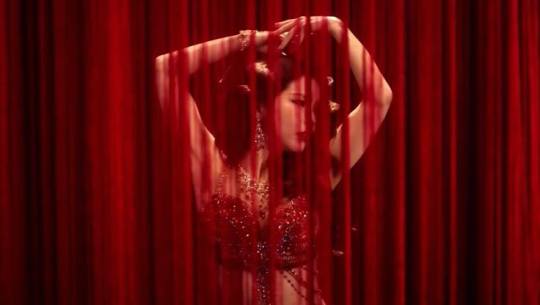
𝓤𝓽𝓽𝓪𝓻𝓪 𝓐𝓼𝓱𝓪𝓭𝓱𝓪
ꜰᴀɪʀʟʏ ɪɴᴅᴇᴘᴇɴᴅᴇɴᴛ, ᴛʜɪɴᴋꜱ ᴀʙᴏᴜᴛ ᴛʜᴇ ꜰᴜᴛᴜʀᴇ ᴏꜰᴛᴇɴ. ʙᴀᴛᴛʟᴇꜱ ʙᴇᴛᴡᴇᴇɴ ꜰᴇᴇʟɪɴɢꜱ ᴏꜰ ꜰᴇᴇʟɪɴɢ ʟᴏɴᴇʟʏ ᴀɴᴅ ꜰᴇᴇʟɪɴɢ ᴀʟᴏɴᴇ. ʜᴀꜱ ᴀ ʀᴇᴠᴏʟᴜᴛɪᴏɴᴀʀʏ ᴍɪɴᴅꜱᴇᴛ ᴀɴᴅ ꜱᴇᴇᴋꜱ ᴛᴏ ᴅᴏ ɢᴏᴏᴅ ꜰᴏʀ ᴛʜᴇ ᴡᴏʀʟᴅ. ꜰʀɪᴇɴᴅꜱʜɪᴘꜱ ᴄᴏᴍᴇꜱ ᴀɴᴅ ɢᴏᴇꜱ ᴘʀᴇᴛᴛʏ ᴏꜰᴛᴇɴ ʙᴜᴛ ᴛʜᴇʏ'ʀᴇ ᴀᴡᴀʀᴇ ᴛʜᴀᴛ ɴᴏᴛʜɪɴɢ ʟᴀꜱᴛ ꜰᴏʀᴇᴠᴇʀ. ꜱᴍᴀʟʟ ꜰᴇᴀᴛᴜʀᴇꜱ ᴀɴᴅ ᴀ ᴘʀᴏᴍɪɴᴇɴᴛ ᴊᴀᴡ. ᴛʜᴇ ᴜɴᴅᴇʀᴄᴏᴠᴇʀ ᴛʀᴇɴᴅꜱᴇᴛᴛᴇʀꜱ.
ɪɴ ᴛᴇʀᴍꜱ ᴏꜰ ꜱᴇxᴜᴀʟ ʀᴇʟᴀᴛɪᴏɴꜱʜɪᴘꜱ, ᴛʜᴇʏ'ʀᴇ ᴘʀᴇᴛᴛʏ ꜱɪᴍᴘʟᴇ ᴀɴᴅ ꜱᴛʀᴀɪɢʜᴛ-ꜰᴏʀᴡᴀʀᴅ ᴡɪᴛʜ ᴡʜᴀᴛ ᴛʜᴇʏ ᴡᴀɴᴛ ᴀɴᴅ ʜᴏᴡ ᴛʜᴇʏ'ʟʟ ɢᴏ ᴀʙᴏᴜᴛ ɪᴛ. ᴛʜᴇʏ ᴡᴏɴ'ᴛ ᴅᴏ ᴛʜɪɴɢꜱ ᴛᴏᴏ ᴇxᴛʀᴇᴍᴇ ʙᴜᴛ ᴛʜᴇʏ'ʀᴇ ɴᴏᴛ ᴠᴀɴɪʟʟᴀ ɪɴ ʙᴇᴅ ᴇɪᴛʜᴇʀ, ᴛʜᴇʏ'ʀᴇ ꜱᴛʀɪᴄᴛʟʏ ᴍɪᴅᴅʟᴇ ɢʀᴏᴜɴᴅ ᴡɪᴛʜ ᴇᴠᴇʀʏᴛʜɪɴɢ. ᴛʜᴇʏ ꜱᴛʀɪᴠᴇ ᴛᴏ ᴘʟᴇᴀꜱᴇ ᴛʜᴇɪʀ ᴘᴀʀᴛɴᴇʀꜱ ᴇɴᴏᴜɢʜ ᴀɴᴅ ᴡᴏɴ'ᴛ ɢᴏ ᴏᴠᴇʀʙᴏᴀʀᴅ. ᴜᴛᴛᴀʀᴀ ᴀꜱʜᴀᴅʜᴀꜱ (ᴅᴇᴘᴇɴᴅɪɴɢ ᴏɴ ᴛʜᴇ ɢᴇɴᴅᴇʀ) ᴀʀᴇ ᴇɪᴛʜᴇʀ ꜱᴛʀɪᴄᴛʟʏ ꜱᴜʙᴍɪꜱꜱɪᴠᴇ ᴏʀ ꜱᴛʀɪᴄᴛʟʏ ᴅᴏᴍɪɴᴀɴᴛ.
𝓓𝓱𝓪𝓷𝓲𝓼𝓱𝓽𝓪, 𝓟𝓾𝓻𝓿𝓪 𝓑𝓱𝓪𝓭𝓻𝓪𝓹𝓪𝓭𝓪 🦁
ʜᴜɢᴇ ᴘᴇʀꜱᴏɴᴀʟɪᴛɪᴇꜱ, ᴘᴇᴏᴘʟᴇ ᴀʟᴡᴀʏꜱ ɴᴏᴛɪᴄᴇ ᴛʜᴇᴍ ᴛʜᴇ ᴍɪɴᴜᴛᴇ ᴛʜᴇʏ ᴡᴀʟᴋ ɪɴᴛᴏ ᴀ ʀᴏᴏᴍ. ᴄᴀʀʀɪᴇꜱ ᴛʜᴇᴍꜱᴇʟᴠᴇꜱ ᴀꜱ ɪꜰ ᴛʜᴇʏ'ʀᴇ ɴᴀᴛᴜʀᴀʟʟʏ ʙᴏʀɴ ʀᴏʏᴀʟᴛʏ ᴀɴᴅ ɪꜱ ᴏꜰᴛᴇɴ ᴛʀᴇᴀᴛᴇᴅ ᴀꜱ ꜱᴜᴄʜ. ꜱᴏᴍᴇᴛɪᴍᴇꜱ ᴛʜᴇʏ'ʀᴇ ᴀ ʟɪᴛᴛʟᴇ ᴘᴏᴡᴇʀ-ʜᴜɴɢʀʏ ᴀɴᴅ ᴄᴀɴ ʟᴇᴛ ᴛʜɪꜱ ɢᴇᴛ ᴛᴏ ᴛʜᴇɪʀ ʜᴇᴀᴅꜱ ᴀᴛ ᴛɪᴍᴇꜱ. ᴡʜᴇɴ ᴛʜᴇʏ ɢᴇᴛ ᴍᴀᴅ, ʏᴏᴜ'ʟʟ ᴡɪꜱʜ ʏᴏᴜ ɴᴇᴠᴇʀ ꜱᴀɪᴅ ᴀɴʏᴛʜɪɴɢ ɪɴ ᴛʜᴇ ꜰɪʀꜱᴛ ᴘʟᴀᴄᴇ. ʟᴏɴɢ ᴀʙᴜɴᴅᴀɴᴛ ᴀᴍᴏᴜɴᴛꜱ ᴏꜰ ʜᴀɪʀ ᴀɴᴅ ᴍᴏꜱᴛʟʏ ᴛᴀʟʟ ɪɴ ʜᴇɪɢʜᴛ ᴡɪᴛʜ ʜᴜɢᴇ ꜰʀᴀᴍᴇꜱ.
ꜱᴇxᴜᴀʟʟʏ, ᴛʜᴇʏ'ʀᴇ ᴀʟꜱᴏ ɪɴᴛᴇɴꜱᴇ ʙᴜᴛ ɪɴ ᴀ ᴏᴠᴇʀʟʏ ᴄᴏɴꜱᴜᴍɪɴɢ ᴡᴀʏ. ᴛʜᴇʏ ᴡᴀɴᴛ ʏᴏᴜ ᴛᴏ ᴍᴀᴛᴄʜ ᴛʜᴇɪʀ ᴇɴᴇʀɢʏ, ᴛʜᴇʏ'ʀᴇ ɴᴏᴛ ɪɴᴛᴏ ᴛʜᴇ ᴏᴠᴇʀʟʏ ɢᴇɴᴛʟᴇ ᴏʀ ᴠᴜʟɴᴇʀᴀʙʟᴇ ᴛʏᴘᴇꜱ ᴏꜰ ᴘᴀʀᴛɴᴇʀꜱ (ᴛʜᴇʏ ɴᴇᴇᴅ ꜱᴏᴍᴇᴏɴᴇ ᴡʜᴏ ᴄᴀɴ ᴍᴀᴛᴄʜ ᴛʜᴇɪʀ ꜰʀᴇᴀᴋ). ᴅᴇꜰɪɴɪᴛᴇʟʏ ᴅᴏᴍɪɴᴀɴᴛ ᴀɴᴅ ᴡᴏɴ'ᴛ ᴇᴠᴇʀ ᴛᴇᴇᴛᴇʀ ᴏꜰꜰ ᴛʜᴀᴛ ʀᴏʟᴇ. ᴛʜᴇʏ ᴄᴀɴ ᴍᴀᴋᴇ ʏᴏᴜ ꜰᴇᴇʟ ꜱᴘᴇᴄɪᴀʟ ᴛʜᴏᴜɢʜ.
(I know y'all were waiting for this post for a bit but here it is :) I hope you enjoyed reading it and comment down below if anything resonates.)
#astrology#vedic astrology#nakshatras#ashwini#bharani#krittika#rohini#mrigashira#ardra#punarvasu#pushya#ashlesha#magha#purva phalguni#uttara phalguni#hasta#chitra#swati#vishaka#anuradha#jyestha#mula#purva ashadha#uttara ashadha#shravana#dhanishta#shatabhisha#purva bhadrapada#uttara bhadrapada#revati
640 notes
·
View notes
Text
some astro notes on the EYES
- pisces, especially revati nakshatra can either have very expressive eyes or a blank stare; a gaze that's here, but "not here," a far-off look
- a strong influence of pitta - firey, hot planets like the sun & mars, malefic planets in fire signs can lead to "discolored" eyes that are not a bright white but may have an off-white or yellowish tint
- the whiteness of the eyes is associated with femininity, which corresponds with the water and earth element. kapha tends to give bright white eyes
- ardra nakshatra's deity is rudra, the terrifying form of lord shiva, who is said to have red eyes in some depictions
ardra natives are associated with red eyes and can have a wild, fierce look about them.
ardra is also associated with red eyes via its crying symbolism
& being a rahuvian nakshatra, is inclined to smoke 🌿
- leo rising can potentially bestow "yellow eyes," more prominently in males
- scorpio risings are said to have "power in their eyes," meaning they are very observant and see what people are doing. their eyes can be commanding & intimidating, as well as alluring, scorpio being a water sign
scorpio risings can be observant in a psychological sense, such as a observing body language and trying to gauge emotions and intentions from that, or studying micro facial expressions; observant in the occult sense of observing dreams, astrological studies, etc.
- rahu's nakshatras (ardra, swati, shatabisha) are extremely observant of their surroundings and the physical world they are placed in. immersed in the sights, sounds, smells of their environment, often leading to big, childlike eyes - full of wonder, soaking in the sights & sounds of the world
- the fire element represents vision, so afflictions to the fire signs may afflict the eyesight, depending on planetary conditions
- ashlesha natives have alluring, cat-like eyes that pull you in. eye makeup such as kohl or kajal and mascara can enhance this quality
- chitra natives can have big eyes that tend to narrow significantly when they smile, as well as rohini
- revati, bharani, krittika and venusian natives are good at acting with their eyes. they can excel at dance and can express different emotions with their eyes
- bharani natives can make excellent actors and performers due to being able to cry on command, & how dramatically they can express different emotions and invoke different emotions and reactions in audiences
bharani natives are also prone to crying and may often burst out in tears, though they may not like to show this aspect of themselves
bharani is associated with childbirth and babies who are prone to crying to express emotion.
#pisces#revati nakshatra#revati#pitta#sun#mars#eyes#astro observations#astro notes#ardra#ardra nakshatra#swati#swati nakshatra#rudra#shatabhisha#bharani#krittika#vedic astrology#aries#taurus#gemini#scorpio#scorpio rising#leo rising
675 notes
·
View notes
Text
The Essential Fundamentals of all 27 Nakshatras
Every Nakshatra has a specific theme that represents what it is about. This post embodies short descriptions of each Nakshatra to give a quintessential understanding of their natures.
Ashwini Nakshatra is revered as "The Star of Beauty and Speed."
Ashwini is known giving natural strength, health, and beauty. Natives of this Nakshatra possess a quick, energetic nature that infuses them with a vibrant zest for life. Those influenced by Ashwini have a gift for enhancing the beauty and speed (vitality) of others through medicinal miracles and infusing life into them against all odds and reason.
Bharani Nakshatras is revered as "The star of bearing and supporting new life."
Bharani is known for its nurturing qualities. This Nakshatra symbolizes the act of giving birth to creativity and newness into life. Those born under the Bharani are believed to possess a deep sense of responsibility and dedication towards nurturing a creation's existence, even if it entails personal sacrifices and struggles. Much like the process of childbirth itself, Bharani represents the laborious journey of bringing forth newness into the world, characterized by both the pain and joy that accompanies such a transformative experience.
Krittika Nakshatra is known as "The star of insight."
Krittika natives possess a unique talent for breaking down complex concepts into smaller, more manageable components. With a keen eye for detail, they are able to unravel intricacies that may elude others. These individuals excel at dissecting information and gaining a thorough understanding of intricate subjects. Their precise and methodical approach allows them to navigate through intricate systems with ease, making them masters of subdividing the most challenging of tasks.
Rohini Nakshatra is known as "The star of procreation, creativity, and fertility."
Linked to the moon and the deity Brahma, Rohini embodies the daughter of Lord Brahma, who was the source of his inspiration to bring life into the world. Individuals born under this nakshatra are believed to have an exceptional imagination, brimming with creative thoughts and ideas that foster life and innovation.
Mrigashira Nakshatra is referred to as "The star of searching."
Mrigashira people are often described as eternal seekers, perpetually in pursuit of something just beyond their grasp. They embody a relentless curiosity and an insatiable thirst for knowledge or pleasure, propelling them to explore every possible avenue in their quest for fulfillment. Like a restless deer darting through a dense forest, Mrigashira natives are renowned for their agility in navigating through ideas and concepts, always in motion as they chase the next spark of inspiration or joy.
Ardra Nakshatra is known as "The star of destruction."
The karmic journey of those born under this Nakshatra is characterized by a unique energy dedicated to paving the way for new growth and transformation. Their karmic life aim finds themselves dismantling, destroying, and unlearning old patterns, making room for fresh opportunities and creativity to thrive. Similar to a powerful storm that sweeps away debris, Ardra natives excel at breaking down barriers and obstacles, moving forward with clarity and purpose. Their presence is dynamic and intense, yet ultimately acts as a catalyst for positive change and evolution.
Punarvasu Nakshatra is known as "The star of repetition."
Much like a recurring cycle, those born under this Nakshatra karmically find themselves revisiting situations or opportunities, each time bringing a fresh perspective or renewed energy. These natives living the lesson of learning about how smaller patterns fall within larger ones.
Pushya Nakshatra is often referred to as "The star of devotion and blossoming."
Pushya embodies the significance of maintaining steadfast faith and commitment to core values. This nakshatra imparts the karmic lesson that when we truly believe in our cause, we are on the journey to flourishing and growth. Much like a delicate flower that requires devotion and care to blossom, our dedication to our beliefs and values can guide us towards a life abundant with fulfillment.
Ashlesha Nakshatra is revered as "The Star of Embrace."
Ashlesha is renowned for its deep emotional attachments and intense desires. Individuals with Ashlesha Nakshatra exhibit a fervent clinging to what they love, never letting go easily. There is a profound sense of responsibility towards their loved ones, demonstrating loyalty and dedication that is unmatched.
Magha is known as "The star of gifted power."
The karma of Magha is associated with qualities and abilities that are inherited from one's ancestral family line. Those born under Magha are believed to possess innate gifts and head starts in life, due to the progress they have carried over from a past life. These gifts can be bestowed on them from their family line and passed down. In general, these individuals may find success and recognition coming to them more easily than others, and may excel in areas where they invest minimal effort.
Purva Phalguni is celebrated as "The star of love, romance, and the foundation of good relations."
Purva Phalguni imparts the karmic lesson of recognizing the importance of romantic pleasure while also respecting all aspects of life beyond mere sensual satisfaction. It underscores the value of practicing nobility and exercising restraint to prevent succumbing to excess, lust, and the ensuing suffering that can result from neglecting these virtues.
Uttara Phalguni is frequently hailed as "The Star of Commitments and Marriage."
Uttara Phalguni is linked to karmic lessons focused on embracing love amidst the challenges and ups and downs of unions. Individuals born under Uttara Phalguni are believed to excel at resolving differences and fostering enduring love and intimacy in their relationships.
Hasta is known as "The star of awareness and dexterity."
Hasta Nakshatra symbolizes the deep connection between the mind and hands. It emphasizes the importance of being present and fully engaged in the reality of the world around us. Through karmic lessons, Hasta teaches us that our hands have the power to create wealth and resources through our skills and expertise. It inspires us to wake with the light each day, filled with determination to tackle our goals and ambitions.
Chitra Nakshatra is renowned as "The star of brilliance."
Those of Chitra Nakshatra are distinguished by its capacity to generate complex and innovative designs. Individuals born under this nakshatra are endowed with an innate talent for crafting detailed and multifaceted artworks, whether in technology, architecture, or any other design field. They excel at refining and enhancing existing concepts, demonstrating their profound knowledge and expertise in these areas.
Swati Nakshatra is often referred to as "The star of becoming an individual."
Swati embodies the significance of departing from societal norms and expectations to fully embrace one's distinct identity. This nakshatra inspires individuals to carve their own path and stand out amidst the crowd, even if it requires defying the norm. It serves as a reminder that while nurturing our individuality and uniqueness is crucial, we must also acknowledge our place within a broader collective and aim to foster a connection with the world around us.
Vishakha Nakshatra is revered as "The star of being one-pointed."
Vishakha Nakshatra people are distinguished by their unwavering dedication and decisiveness, steadfastly adhering to their chosen path and goals. Similar to a sailor navigating through turbulent waters, those influenced by Vishakha Nakshatra remain on course until they reach their destination, employing all necessary means to surmount obstacles and challenges.
Anuradha Nakshatra is renowned as "The star of deep devotion."
Those of Anuradha are propelled by an intense sense of love, passion, and commitment, viewing these values as the pinnacle of existence. Tenderness, romance, and affection act as the compass in their lives, molding their actions and decisions with genuine sincerity. Those with Anuradha Nakshatra deeply respect agreements, promises, and laws, understanding the significance of adhering to these values across all aspects of life.
Jyestha Nakshatra is renowned as "The star of the foremost and best."
Jyestha people are often driven by a strong desire for power, prosperity, and a lifestyle filled with enjoyment. They possess a natural strength and determination to excel, using their skills and strength to protect their loved ones. However, the karmic lessons associated with Jyestha Nakshatra caution against becoming overly proud of achievement and position, as this can ultimately lead to their downfall.
Mula Nakshatra is revered as "The star of roots and origins."
Mula represents a profound spiritual journey and a quest to grasp the true essence of existence. Individuals born under Mula are motivated to explore beyond the surface, researching and searching towards revealing the hidden truths of the universe. They are compelled to shatter illusions and liberate themselves from the constraints of superficiality, aiming to establish a connection with the fundamental essence of everything.
Purva Ashadha is renowned as "The star of invincible waters."
Purva Ashadha Nakshatra symbolizes the flowing waters of immense strength and power. These waters have the capability to slice through and obliterate anything in their path, yet they also radiate a soft and cooling essence that renders them both pleasant and bearable.
Uttara Ashadha Nakshatra is often referred to as "The star of ultimate invincibility."
Uttara Ashadha is a true karmic powerhouse, radiating an aura of unbeatable power and strength. Individuals born of this Nakshatra tap into a wellspring of qualities and skills bestowed onto them by the divine. They are driven by an ambitious, relentless drive, pooling resources and gathering social support whenever necessary to achieve a vision or common goal.
Shravana Nakshatra is renowned as "The star of listening."
Shravana embodies the significance of acquiring knowledge and understanding through attentive listening. Individuals born under this nakshatra are endowed with the karmic gift of receptiveness and open-mindedness, enabling them to broaden their wisdom and power. By engaging in active listening without prejudice, they can gather invaluable information and insights, which in turn fosters personal growth and success.
Dhanishta Nakshatra is revered as "The star of sound and action."
Dhanishta personifies the profound karmic insight that the power of sound is of utmost importance. Those born under this nakshatra hold the conviction that all that is heard, received, and comprehended through listening should be applied practically. This belief underscores the significance of not just listening attentively but also acting on the insights gained, going on instinct, and not questioning what must be done.
Shatabhisha Nakshatra is revered as "The star of hundreds of healers or cures."
Shatabhisha Nakshatra is linked to the karma of healing and curing society through enigmatic distant methods of observation. It is regarded as a guardian, overseeing all activities, and evaluating individuals or society with fair and objective perspectives. Individuals born under the influence of Shatabhisha Nakshatra possess the ability to initiate movements and drive change in the face of injustice, should it be deemed worthy of correction.
Purva Bhadrapada Nakshatra is often referred to as "The star of the blessed step."
Purva Bhadrapda is believed to guide individuals towards spiritual enlightenment by highlighting the transient nature of physical existence. Those born under this nakshatra embark on a journey towards understanding the impermanence of life, which leads them to value moments and experiences deeply, recognizing the preciousness of time. This insight enables them to view the world with a critical eye, allowing them to fully embrace the present moment and focus on actions that foster personal growth and the realization of ultimate wealth - which is the recognition of life's fleeting nature.
Uttara Bhadrapada Nakshatra is revered as "The star of the latter blessed steps."
Uttara Bhadrapada embodies a deep karmic acceptance of life's inevitable endings. Individuals born under this nakshatra grasp the spiritual importance of embracing change and transformation, recognizing that death is an inherent part of life. This acceptance fosters a profound sense of inner wealth and prosperity, as people fully embrace the new state of being that emerges from relinquishing the old.
Revati Nakshatra is revered as "The star of prosperity and wealth."
Revati carries significant karmic significance in the pursuit of resources, highlighting the importance of steering clear of greed and fostering compassion by sharing wealth with those in need. Individuals born under this nakshatra are believed to possess a unique ability to guide the lost, utilizing whatever resources they have at their disposal. By aiding others in achieving their goals and getting to a destination, Revati individuals can, in turn, accumulate greater prosperity through "good karma" earned.
Nakshatra Notes Masterpost (Link collection of more detailed paragraph descriptions of all 27 Nakshatras, both positive and negative traits)
#astrology#vedic astrology#nakshatra#naksahtras#ashwini#bharani#krittika#rohini#mrigashira#ardra#punarvasu#pushya#ashlesha#magha#purva phalguni#uttara phalguni#Hasta#Chitra#Swati#Vishakha#Anuradha#Jyestha#Mula#Purva Ashadha#Uttara Ashadha#Shravana#Dhanishta#Shatabhisha#Purva Bhadrapada#Uttara Bhadrapada
661 notes
·
View notes
Text


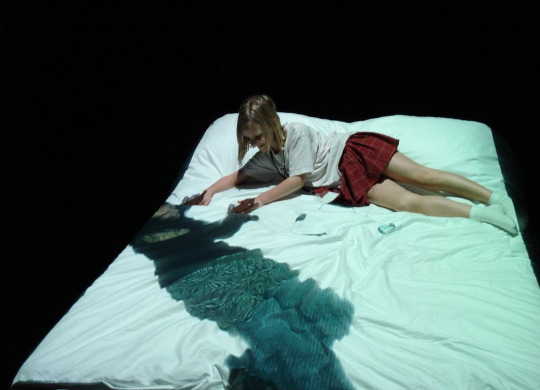
astro observations #4
- The idea that your north node = fate and destined path doesn’t feel accurate. After all, north node aka rahu is literally illusion and material obsessions and is also considered a malefic in multiple astrological circles. I find it to be more of an indicator of what our fantasies and guilty pleasures may be.
- People with prominent Leo/Aquarius axis tend to focus their astrological study on their personal placements from what I noticed. As they get deeper however, they start to venture into what other placements might be like. But for most part, the focus tends to be on their placements first.
- 7th/8th house placements tend to be the opposite, being very curious to know why people around them, their role models, and others in general act the way they do and therefore using astrology to understand that
- 9th house placements are the ones who study every placement just for the sake of it or out of curiosity, some 3h placements might also
- Taurus + Leo = curly hair
- Taurus placements, especially if aspecting Lilith or mars or coupled with mars ruled placements, tend to be into vampires bc throat (Taurus) and blood and injury (Mars) as well as the seductive/taboo nature of vampires (Lilith)
- 3h Saturn/ 3h in Capricorn might take quite a while to get their drivers license
- What others tend to say about u : 3h from 7h : aka the 9h.
e.g. 9h in Aquarius : people talk about how you’re unique, popular or friends with a lot of people, humanitarian. They might also discuss how you’re eccentric, disconnected or apathetic.
- Whatever houses are ruled by Venus in your chart can give you an idea of how your relationships impact you as well as how you behave when in a relationship.
e.g. Libra risings have Venus ruling their first and eighth house, they tend to have very transformative relationships that end up changing them completely. They might also benefit from personal glow-ups during certain relationships thanks to their partner’s resources. Opposite can be true with weak Venus or malefic influence on the houses of Venus.
- 8h is underrated as an intelligence indicator. That’s the house of research, uncovering mysteries, and finding out the hidden. If one of the most common intelligent tropes -detectives and mad scientists- work within 8h themes, that is for a reason
- 6th house Lilith could indicate suffering from eating disorders.
- I noticed that even people who don’t know anything about astrology (sometimes especially them lol) tend to have markers of their signs all over their online presence. my ardra stellium friend has pearl as his username (ardra is symbolized by the diamonds and jewelry), a lot of shatabisha (especially the men) like wearing bracelets and rings (reminiscent of the empty circle that symbolizes shatabisha) etc.
- 10th house could signify what traits do you have that are different or stand out from ur family. For example, Jupiter in the tenth house could mean different beliefs, maybe a taller build compared to your parents, I also see it as which members of your family do you resemble the most. 10th house Jupiter might look like their grandparents while 10th house sun their dad, and moon their mom etc.
- Saturnian tend to be gatekeepers because Saturn = scarcity and limitations.
- 4h mars/sun could indicate having more close male friends n vice versa for 4h Venus/moon.
- Sun nakshatras and ashwinis look really good when the sun is shining on them. They might be particularly fond of golden hour selfies.
- 11h synastry can indicate starting a business together, whether it’s benefics or malefics will indicate if the business will succeed or not.
- Lacking aspects to the luminaries can mean feeling disconnected from your parents, as if there’s a certain distance between you and them that can’t be bridged. An empty 3h + unaspected 3h lord can also indicate feeling that way towards your siblings.
- A strong Mars + Venus = good dancer. Also prominent dhanista and snake yoni Nakshatras (Rohini, mrigashira).
- Anna Popplewell and Nancy ajram look similar and I found they have quite the similar placements besides both having nodal (Ardra/Mula) and Saturnian (Uttara Bhadra/Anuradha) influence.






Nancy Ajram (Top) : Jupiter in Anuradha, Sun DK in the first Degree, Sun and Mars in Krittika, Ketu in Mula.
Anna Popplewell (Bottom): Venus in Anuradha, Sun DK in the first degree, Jupiter in Krittika, Sun, Mercury, and Saturn in Mula.
this is it for today <3 please don’t hesitate to share if any of this resonates!
#astro observations#astro notes#astro placements#astrology notes#astrology observations#vedic astro notes#vedic astrology#ardra#ashwini#shatabhisha#mula#7th house#8th house#aquarius#leo#9th house#taurus#10th house#10h jupiter#11h synastry#saturn nakshatras#sun nakshatras#3h saturn#6h Lilith#4th house#aries#Libra risings
755 notes
·
View notes
Text
Why certain people capture the spotlight?⭐️
1. The luminaries, the Sun and Moon naturally draw attention in a birth chart. People with strong Sun or Moon placements tend to light up any room they enter, effortlessly standing out.
Just like everyone loves capturing the beauty of a sunrise or the glow of a full moon, those with these placements have a magnetic energy that people can’t help but notice.
It’s almost like they’re always in the spotlight, which is why they often feel the need to look their best.☀️🌕
Beyoncé, Purva Phalguni Sun, Chitra Lagna and Venus.

Michael Jackson, Magha Sun and Shatabhisha Lagna.
Bella Hadid, Purva Phalguni Moon and Lagna.
There's not much to say about Beyoncé and Michael that isn't already well-known—they're icons in their own right, the biggest stars of our time. Bella Hadid has become the most photographed model off-duty and in 2022, she was named Model of the Year.
Gia Carangi, often hailed as the first true supermodel, paved the way for all the other supermodels that followed. She had a Shravana Sun and Lagnesh, with Hasta as her Lagna and a Shatabhisha Moon.

Britney Spears, Shravana Moon, was one of the most photographed stars for a while. The crazy amount of media attention even led to harassment and really affected her mental health.

Gisele Bündchen, Pushya Sun and Purva Phalguni Lagna, the only "Ubermodel"-that means being more than a supermodel.
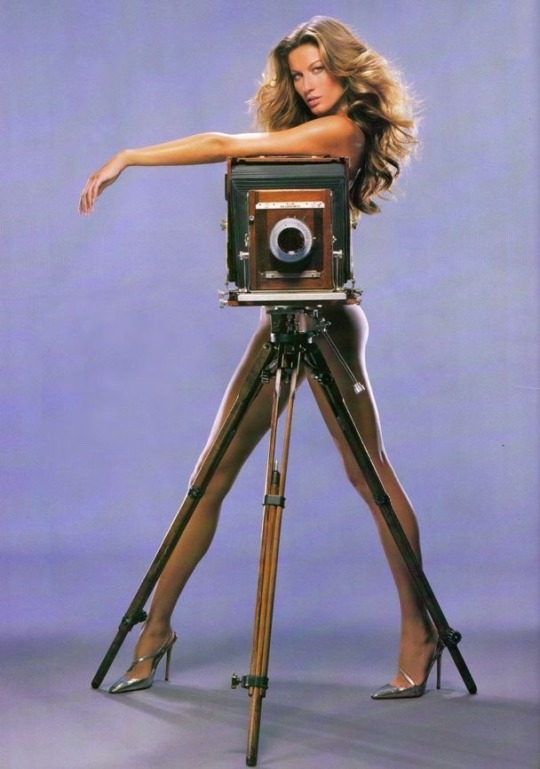
Lauren Hutton, Pushya Moon and Lagna, holds the record for the most Vogue covers—26 in total.
I previously explored about how lunar-dominant people often achieve significant success on social media.
2. Chitra Nakshatra, known as the "Star of Opportunity," carries the Shakti of "accumulating merit." The word "Chitra" translates to "wonderful" and "pleasing to look at," as well as "illusion."
The deity of this nakshatra is Tvastar, the celestial architect who designed the universe. The symbol of Chitra is the "pearl" or "bright jewel," symbolizing beauty and uniqueness.💎💍
"Chitra" also means "picture," so individuals with this nakshatra are often naturally photogenic. 📸Tvastar, as the creator of Maya (illusion), grants those under Chitra the ability to craft captivating personas, making them talented models, photographers, actors, and successful on social media.
Kim Kardashian, Chitra Sun, built a career centered on her image. As one of the first influencers, she's become one of the most prominent and influential figures on social media. In 2015, she released “Selfish”, a book featuring a collection of her selfies.
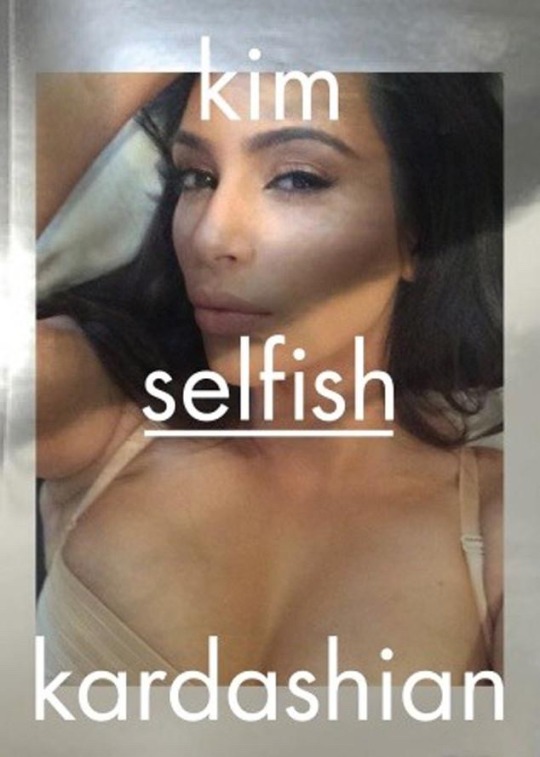
Cindy Kimberly, Chitra Moon and Shravana Lagna, shot to fame because of her striking beauty. Her big break came when Justin Bieber posted about her on his Instagram. Now, she’s a major beauty influencer and a well-known model.

Anna Nicole Smith, Chitra Sun and Hasta Moon, made a name for herself as a model, completely based on her image. She was once one of the most photographed women in the world, and photographers loved working with her, often saying she was one of the easiest and most exciting people to capture on camera.
The thing with Chitra individuals is that, because of Tvastar, the celestial craftsman, their features often become iconic. For instance, Kim drew the attention to the BBL, Cindy’s nose has become a major inspiration for many women, and Anna Nicole brought attention back to curvy bodies at a time when the "heroin chic" look was in vogue, reminiscent of Marilyn Monroe's era.
3. Dhanishtha🌟 Shakti is "power to give abundance and fame," meaning "the most famous," "the most heard of." This nakshatra is recurring in the charts of people who usually marry famous individuals, making them well-known as well, often attracting more attention than their partner.
Princess Diana, Dhanishtha Moon and Magha Lagnesh, was the most photographed woman in the world, holding the record for the most sold-out paparazzi pictures, including one that sold for 6 million dollars.

Marilyn Monroe, Rohini Sun, Dhanishtha Moon, and Ashlesha Lagna, was also one of the most photographed women of her time.

4. Shatabhisha, meaning "hundred stars" and represented by a veiled star and an empty circle, is a nakshatra ruled by Rahu. ⭕️
This nakshatra is associated with illusion, the power to effect radical change, innovation, the foreign, esoteric influences, and trends. The empty circle can also symbolize the idea of a cult or community, like the Navy for Rihanna.
Rihanna, Shatabhisha Sun, stands out as one of the most influential artists and fashion icons. She has consistently set trends in the fashion world, with her style serving as an inspiration to many. Recently, her maternity looks have redefined how celebrities approach their appearance during pregnancy, bringing a stylish twist to the norm.

Demi Moore, Lagnesh in Shravana and Jupiter in Shatabhisha in the first house, set a trend for nude pregnancy photoshoots. At the time, this was quite controversial, but it has since become a common practice not just among celebrities, but also for non-celebrity women.
Elizabeth Taylor, Sun in Shatabhisha, was also a major target for paparazzi. George Hamilton once remarked:
"I remember when the word 'paparazzi' came along, and it just meant a bunch of guys who were all photographers looking for Elizabeth Taylor. Desperately looking for Elizabeth Taylor! And that was the beginning of paparazzi. They were not going for glamour anymore. They were going for the destruction of glamour."
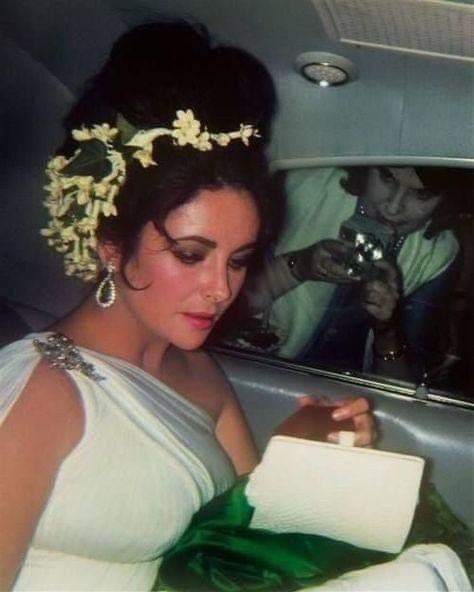
#astrology notes#vedic astro observations#vedic astro notes#astrology#vedic astrology#vedic chart#astro notes#nakshatra#shatabhisha#shravana#ashlesha#dhanishta#chitra nakshatra#hasta
515 notes
·
View notes
Text
Future Spouse Based on Nakshatra - Pt. One
Please read the following for accuracy:
Check for which nakshatra of your dakarkaka.
You may want to check the nakshatra of your Venus (for wife) and Jupiter (for husband) as well.
You may want to read for your moon & AatmaKaaraka nakshatra to see if the traits apply to you.
DISCLAIMER: Keep in mind accuracy is influenced by the ENTIRE natal chart.
SHRAVANA:
General Neutral traits:
Often tall & lean. Ofc not always.
Talkative. Often witty/clever & educated.
Wealthy - Can come from a family that has a known name within their community. Or they will build wealth and become known in their community.
Drawn to social & humanitarian causes. They can help change lives - in small ways or big. EX: Provide jobs, Provide help of some sort to people who need it.
Modest person - may express this as being mostly uninterested in materialistic things.
Quick learner. Good listeners Good teachers & counsellors.
Often marry partners who are helpful to them. Spouses can be open minded. Married life is generally said to be good.
Negative traits:
Open minded views BUT stubborn to change views once decided on.
Gossip often. Jealous people. This creates many enemies/haters. This will be a problem as they often care A LOT about their reputation. However, it is only a problem IF people find out. Often, they are generally well liked & well spoken upon meeting.
ASHLESHA:
General Neutral traits:
Responsible. Independent. Protective. Likely due to being the eldest sibling.
Analytical & Clever.
Good communication skills - writing or speaking.
Good humour. Entertaining personality. As a result a popular personality.
Leadership qualities. Likely to work their way up in their industry or company.
Adaptable & philosophical side to them.
Negative traits:
Intelligence can be used to manipulate.
Secretive. Keep true feelings to themselves.
Prone to depression, anxiety, and overall negative feelings. May be due to keeping a lot to themselves. Can feel burdened with too much responsibility.
VISHAKHA:
General Neutral traits:
Round face. Often Attractive. Cute & soft appearance. Simple modest style.
Attracts jealously - sometimes from family members of the same sex. EX: younger sister loves you but dislikes being in your shadow. Mother loves you but criticizes your life choices - career or romantic partner or other things.
Good communicators. Persuasive. May enjoy reading/writing poetry.
Success comes at their own efforts. If they desire it AND work for it, they can succeed in academics & career.
Leadership qualities combined with their communication makes it likely they have leadership roles in career - EX: Managing, teaching, someone to be respected/looked up to by newcomers in the field.
Negative traits:
Controlling. Prone to jealously. This can lead to difficult romantic relationships in their younger years.
Others may judge this person on their appearance. People will try to tear them down. Often, they have strong comebacks.
Others may try to take advantage of this person’s good nature. While they appear sweet & polite, they aren’t naive or stupid. They will catch on to people who are untruthful or fake.
SHATABHISHA:
General neutral traits:
Large forehead, attractive eyes. Prominent butt.
Honest - sometimes harsh. The type of person who may unintentionally hurt your feelings. Speak before thinking.
Good memory. Analytical. Likes to dig deeper - get to the root of the problem. This may make them good in fields of research like sciences.
Better writers than they are talkers. Clever people.
Able to defend themselves. & often it is said they will defeat their haters & conquer despite obstacles.
Likely to enjoy thinking type games - EX: Wordle, crosswords, puzzles, chess, checkers, etc.
Negative traits:
Argumentative. Fights with family. Likely misunderstood by the family. Results in anger for the family.
Being misunderstood makes them uncommunicative. Will struggle with periods of loneliness in life.
Wish to hide any signs of weakness. May appear emotionless/lacking compassion - however, they are compassionate, they just don’t like showing it.
Stubborn.
Feel restricted. Experience periods of deep isolation.
JYESTHA:
General Neutral traits:
Curly hair. Sharp features. Above average height. Muscular body. Generally, attractive. Eventually, become physically active.
Generally small social circle - few true close friends.
Gain wealth later in life. Often the most successful in their family.
Independent. Doesn’t like to rely on others. Good organizer.
Generally humble, chill/down to earth.
Negative traits:
Bad childhoods. Struggles in early life. Anger towards family. Ego is a problem with these people. Unlikely to fully resolve a conflict - will hold secret resentment.
Manipulative tendencies - Secretive about true feelings/intentions.
ROHINI:
General Neutral traits:
Often attractive. Broad shoulders. Lean body type.
Polite & Charismatic. Good listener. Helpful. Builds good karma. Often popular & social.
Generally truthful but will lie to appear nice.
Responsible. Strong devotion towards their family. Will go out of their way to help family and other loved ones.
Often has a good education. Good career. Financially does well.
Good moral compass. Strong sense of purpose - this can manifest as being career orientated.
Negative traits:
Can be quick to anger. Can seek revenge. Difficulty forgiving. Difficulty holding oneself accountable.
Indulgent side shown after marriage - EX: they may end up indulging too much in foods that are bad for their health. They may overspend/become overly materialistic.
MRIGASHIRA:
General Neutral traits:
Long faces. Large bodies - may be bulky or physically tall.
Friendly. Good social life - often well-liked/popular.
Intelligent. Curious, open to learning new things. Witty person. Flirty.
Good communicators. Good debaters. Enjoy learning more/exploring more.
Action orientated people. Hardworking people. Leadership roles in career.
Negative traits:
Short attention span. Many interests. Do not realize when they are being friendly or being flirty - may upset their marriage partner.
Experience bad relationships -could become suspicious of their partners.
Secretly desire being the center of attention. Insecure. Need for validation.
PURVA BHADRAPADA:
General Neutral traits:
Often tall. Expressive eyes. Often smiling. Can appear mischievous.
Unique people - unconventional behaviours &/or interests.
Logical. Witty. Success in academics is likely.
Self-reliant. Good communicators. Likely to obtain good to moderate wealth.
Imaginative. Future orientated. Dislikes injustice.
Negative traits:
Eccentric behaviour can make them unpredictable. Not the best person to depend on.
Not the most generous. Understanding to other’s issues but at the end of the day, they’re looking out for their own desires.
Later in life, must be cautious of financial or marriage problems. These problems are often a result of immature behaviours. They can be resolved if correct steps are taken.
UTTARA PHALGUNI:
Mix of sharp and soft features. Narrow, sharp eyes. Soft cheeks & face. Sharp jawline. Smaller forehead.
Friendly. Well liked. Benefits from connections. Mostly will experience a comfortable life.
Artistic interests. Ambitious. Like to create.
Compassionate. Generous. Reliable. Dependable. These traits make them popular. Their connections help them gain comfort & wealth.
Open minded to an extent. Certain beliefs are unchangeable with these individuals.
Negative traits:
Receive a lot of help and luck - they may not acknowledge this/be ungrateful. EX: Claiming to be self made when it is not true.
Can have a “my way or no way” mindset at times. Some will view them as arrogant and bossy/demanding.
REVATI:
General Neutral traits:
Moderately tall. Good complexion. Heart-shaped/pouty lip. Stick out in a crowd due to appearance.
Good hygiene. Sociable. Well-liked by most. This can help them advance in career.
May have a wealthy or well connected family. This can help them in career or education. EX: Parents will pay tuition or for transportation.
Lover of animals. Nurturing personality - however, often have children later in life or not at all.
Creative. Artistic interests or skill like drawing/painting as a hobby.
Negative traits:
Vicious when hurt. Can become angry when they feel their compassion & generosity is not being reciprocated.
Karmic relationship with people in the family.
Struggle with insecurities. Results in self doubt & low self esteem.
#astrology observations#astrology#ashlesha#sravana#rohini#jyestha#shatabhisha#vishakha#nakshatras#vedic astrology#vedic astro notes#vedic astro observations#mrigashira#purva bhadrapada#uttara phalguni#revati
893 notes
·
View notes
Text
27 NAKSHATRAS THROUGH MANY FACES
you may start to see the nakshatras next to each other subtlety inheriting the same traits from one another no matter how much in contrast their cycles are. i notice the features progress from the previous nakshatra, without completely losing the passed down blueprint. i realized this as i scrolled through this order of collages. for example, mula and jyestha honestly look the most similar to me (the whole transition from anuradha to purva ashada, actually).



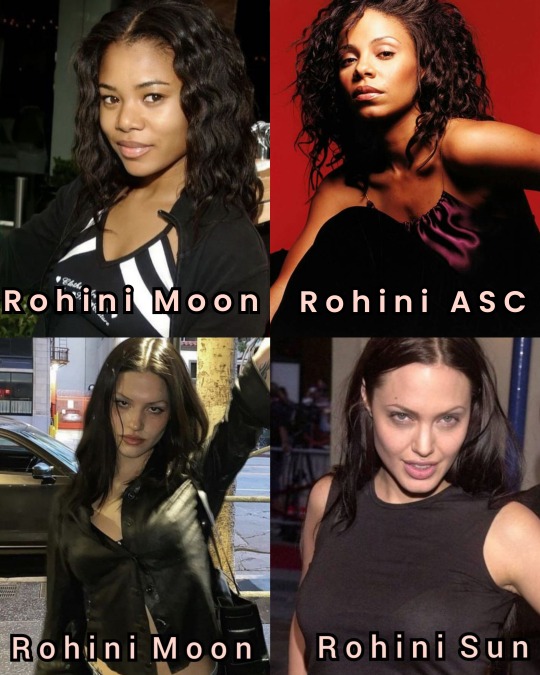

















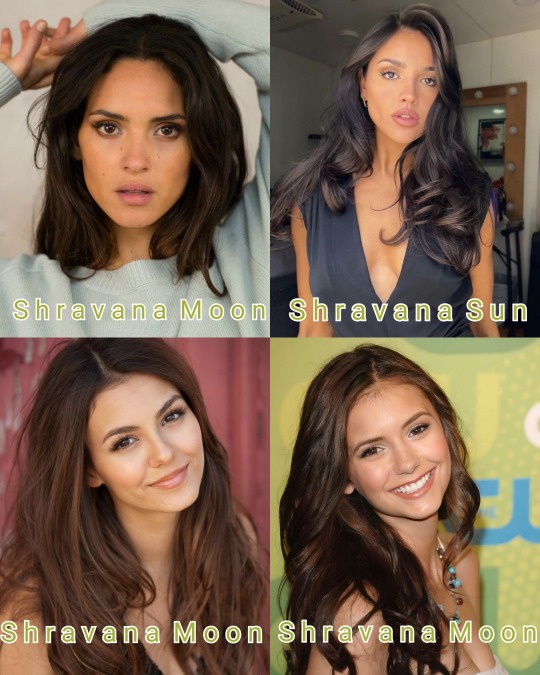

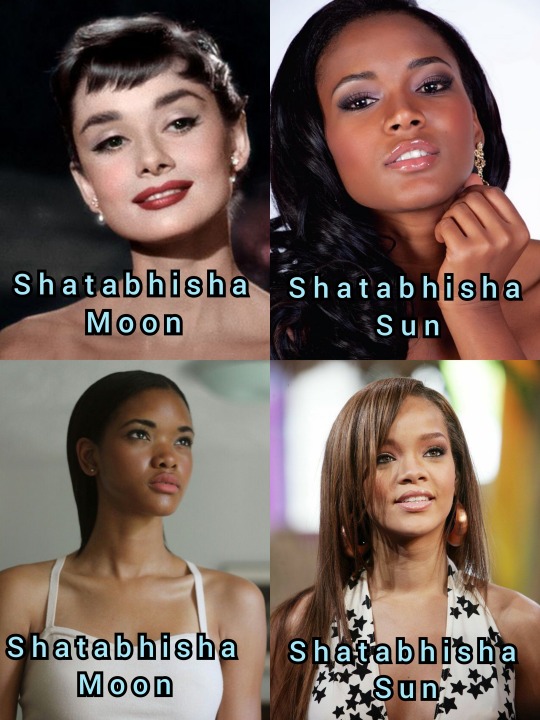



Honourable mention

While Mula natives usually have elongated faces much like Purva Ashadas, it's always interesting to see the different manifestations of physiognomy of the same nakshatras. Had I done that, this thread would have been a lot longer. You would think I should have added Kendall Jenner-Emily Ratajkowski as a pair in the Uttara Bhadrapada section — but notice how they're physically set apart from other natives. There are a variety of ways a nakshatra can look on our faces, I notice this when I'll find a pair of natives who look similar but they are their own set from other natives under the same nakshatra. Keep this in mind, there isn't always a certain look.
Another addition, trine nakshatras can resemble one another. I wanted to add these final pictures to reach the image limit.


sowwrry im obsessed with magha/mula women ^.^
#ashwini#bharani#krittika#rohini#mrigashira#ardra#punarvasu#pushya#ashlesha#magha#purva phalguni#uttara phalguni#hasta#chitra#swati#vishakha#anuradha#jyestha#mula#purva ashada#uttara ashada#shravana#dhanishta#shatabhisha#purva bhadrapada#uttara bhadrapada#revati#vedic astrology#astrology#astro observations
1K notes
·
View notes
Text
Vedic Observations #3
✶⋆.˚ Rohini, Mrigashira, Ashlesha, and Uttara Bhadrapada are very prominent in dancers. They tend to be flexible, fluidity, and hypnotizing type of dancers and I've also noticed that a lot of them can do flips and tricks. It all makes sense since they're all connected to snakes. 🐍


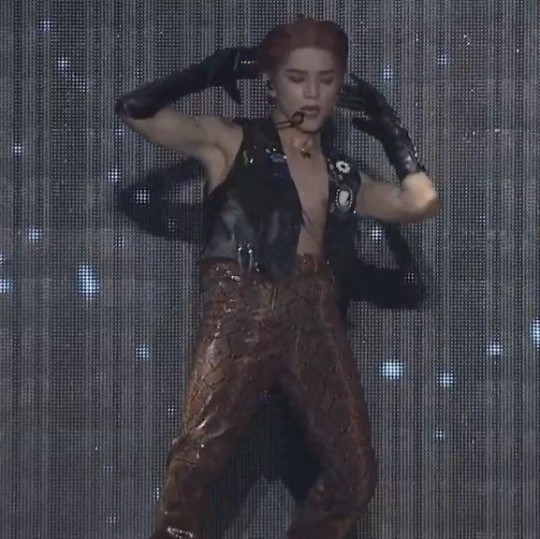
✶⋆.˚ I absolutely love and adore Bharani women so damn much, they're so motherly and protective! My mother is a Bharani Sun and she's highly respected by those close to her and people, even men tried to get with her including past partners. Tifa Lockhart from Final Fantasy VII a Bharani Sun, is a prime example of what I'm talking about. (She's my favorite character and to my mom too!)


✶⋆.˚ The nakshatras that's the most sexualized in society and in the world are Rohini, Bharani, Ashlesha, Purva Phalguni, and Purva Ashadha. The opposite sex tends be obsessed or lust over their looks, body, and appeal. For example Lugi Mangione whose a Bharani Sun and Purva Phalguni moon is accused of shooting the CEO of UnitedHealthcare has been going viral since 2024 because of his attractiveness and several of Luigi's fans are even going as far to leak his nudes.
✶⋆.˚ When it comes to Martial Arts, you'll mostly see a lot of Martial Artists have Krittika, Rohini, Ardra, Pushya, Ashlesha, Vishakha, Anuradha, Jyestha, Mula, Shatabhisha, and Purva Bhadrapada in their big three.
✶⋆.˚ I calculated the birth charts of 24 popular fashion designers and the four nakshatras that tied 1st for Sun, Moon, and Ascendant was Shatabhisha, Rohini, Ashlesha, and Bharani.
✶⋆.˚ Chitras are candidly one of the most fashionable nakshatras out of the bunch. They're very good at detail and knows what goes together or not. It's not surprising that a ton of fashion designers have Chitra in the three, big six, along with Rahu and Ketu. These are the kings and queens of designing.
✶⋆.˚ Dhanistha natives are not only famous but also trendsetters too! Even after their death they still remain memorable and talked about all around the world, *ahem* Marilyn Monroe a Dhanistha moon. They really are iconic stars and beauties, Dhanistha men and women are the definition of walking celebrities even if they're regular people others will see them as someone to be admired.
✶⋆.˚ Rohini is the epitome of beauty and magnetism. This is truly one captivating star, these natives are so beautiful and effortlessly seductive. They naturally attract attention from everyone and have people simping over them all the time. Rohinis are always chosen for things and tend to be exceptionally popular among masses for their sex appeal, charm, and enchanting looks. (Also Spellbinding Eyes! 👀✨️)



✶⋆.˚ Moon ruled nakshatras (Rohini, Hasta, and Shravana) posses a natural talent in gathering everyone together just like the Moon itself, it's mesmerizing glow attracts billions with ease. Millions of individuals easily looks up and admires them to a large amount that it can cause cult like followings, they have a massive influence over the masses and this can lead to big time fame.
#vedic astro observations#vedic astro notes#bharani#krittika#rohini#mrigashira#ardra#pushya#ashlesha#purva phalguni#hasta#chitra#vishakha#anuradha#jyestha#mula#purva ashadha#shravana#dhanishta#shatabhisha#purva bhadrapada#vedic observations
268 notes
·
View notes
Text
Vedic astrology notes
Based on my own experiences
• shravana girlies are loved by other women and the type to attract both genders. Their femininity is strongly felt 🎀
• anuradha is strongly associated with spiders , spiders become mostly significant for them when they're conquering their fears and owning their power 🕷
• bharani women make rly good leaders as they seem grounded but also people tend to look up to them. Venus energy is elite ✨️
• tiger yonis (chitra/vishaka) are fierceee badass bitches they can come off as Intimidating but ppl can't help but notice them 🐆
• vishaka women start out as "good girls" from a young age but the more society or people try to control them they bottle it up and then lash out or spiral out of control at one point becoming destructive, these women grow more into themselves later as they find it important to be authentic and true to who they are , thats how they shine🌻
• ashlesha women can bring out the worst in someone like they really know how to push someone's buttons lol
• mrigashira women are very smart and intellectual they tend to follow their logic rather than their heart when it comes to relationships 💭 they also can keep secrets v well
• krittika women tend to have messy love lives with love triangles or cheating but they're also v attractive to the opposite sex
• revati women have 2 sides to them they're either badass from the outside and soft from the inside or they show their softness but internally they're badass and smarter than they led on
• jyestha women have so much sex appeal and they're not afraid to show it. They tend to have issues with other women whether its jealousy or competition but that doesn't take away from their success. Jyesthas end up being on top they make sure they win 🔥
• purva phalguni fr are sex freaks both men and women , but they can also channel all that sexual energy and passion into their creations which makes them very passionate and creative people overall
• shatabhisha women are so smart especially when it comes to getting info and secrets out of people but its mostly not for personal gains but for the highest good 👀
• can we talk about swati women and how they're strongly associated with cosmetics and beautification? 💄
• purva bhadrapada women hate being controlled or restricted especially when it comes to ideologies, concepts or beliefs. They don't like to be put in a box or labeled and would push against those barriers
Let me know if I should make more of these or if anything resonates
#vedic astro notes#astrology notes#nakshatras#nakshatra notes#vedic astrology#mrigashira#ashlesha#anuradha#jyestha#rohini#magha#swati#bharani#krittika#purva phalguni#chitra#vishaka#shravana#shatabhisha#revati#sidreal astrology#astro notes#claire nakti#purva bhadrapada#purva ashadha#jyotish
1K notes
·
View notes
Text
The Circle that is Shatabhisha


Within the heart of the sign Aquarius from 6°40' to 20°00'
Yoni Animal - Horse
Deity is Varuna
Shatabhisha is a Rahu and Saturn ruled nakshatra at the heart of Aquarius, the name means “hundred physicians”
*Many natives are drawn towards medicine, healing, astrology, occult, and psychology.*
Symbolized by the empty circle, which can be translated as an empty void for cultivation. Most of the themes for Shatabhisha are of healing, mystery and secrecy. Natives of this nakshatra have an analytical and investigative mind, often seeking the truth and deeper meanings. They are independent and rebellious; they prefer solitude but can also be unconventional in challenging societal norms.

Going back to preferring solitude, a lot of these natives often keep their thoughts private and could experience phases of seclusion and loneliness. These natives care deeply but also could struggle to express their emotions in full depth. We saw this with Chappell Roan in communicating with her fans about respecting her privacy and that when she’s not on the clock, she does not want to be bothered. It sparked a huge debate online about celebrities granting servitude to people whenever and wherever fans wanted their time—or even the press not being respectful.

This Nakshatra represents deep healing, hidden knowledge, and cosmic truths. People born under Shatabhisha are often misunderstood visionaries who seek to break illusions and uncover reality. They walk a fine line between science and spirituality, often making a lasting impact on the world.
Shatabhisha are also known to be justice seekers, the deity Varuna governs over divine justice ensuring those who act unfairly will face karmic consequences. We saw this through Rihanna having her messy twitter era and just getting into fights with certain individuals online. However, I know there are notorious Shatabhisha natives that have committed major crimes or have been to jail, their karmic consequences work on themselves as well. Shatabhisha individuals could go either way on the scale of good or bad. But you will notice that a lot of natives have a cult following no matter if they are morally good or bad. You will notice these natives are difficult to control, and behave a bit on the wild side, it’s hard to tame them. This is where they get their controversial reputation.

Varuna is the guardian of the waters and the one who grants Amrita (divine nectar of immortality). I would argue that this is what grants these natives beauty, aging with grace. For this represents deep healing, rejuvenation, and the power to transform pain into wisdom.
The symbol of the circle is representative of these natives’ tight knit, cult like following, it relates directly to the natives having a devoted fanbase—their energy being like an intimate, sacred space. Their fans aren’t just about their art but about their community and identity, the circle is like their performance space, where the artist becomes the center of transformation. However, the circle could work as a veil or mask, as Shatabhisha is known for their mystery and reinvention. Many have cultivated a persona to separate their private and public selves. Their cult following exists because they create a new world, a new identity, and a sense of belonging. Rihanna, Audrey Hepburn, Kehlani, Chappell Roan, all have cult followings. They can truly do no wrong in their fanbase’s eyes when being controversial or unconventional. The empty void for cultivation is endless with these natives as they are constantly coming up with new creative ventures.


Native Placements
Mia Goth - Shatabisha Moon
Chappell Roan - Shatabisha Sun
Rihanna - Shatabisha Sun
Kehlani - Shatabisha Moon
186 notes
·
View notes
Text
Some notes on Shatabhisha 🔮🗒️

Shatabhisha -the 24th nakshatra. Ruled by Rahu contained writhin Aquarius rashi. The yoni animal is a female horse. The symbol is 1000 stars. The diety is Varuna.
Here are some observations I made about them from my perspective. This can apply to Sun, Moon, Ascendant, or Atmakaraka in Shatabhisha. Honorable mention Ketu in Shatabhisha.

⌦ These natives are tall. Especially men with this Nakshatra will be very tall, lanky build.
⌦ Similar to the other Rahu Nakshatras like Ardra and Swati, Shatabhisha has piercing eyes. No matter the color, these natives have an intense gaze that instantly melts people. It is common they have a shocking eye color, that seems electric. Like shocking green or blue eyes.
⌦ They tend to look famous. Something about them is unique and distinguished, yet highly attractive. They naturally have that “it” factor. They look cartoonishly good, like a anime character.
⌦ Now one thing I’ve noticed is these natives behave a lot like how the name “Shatabhisha” sounds. It sounds like you’re saying “shadow”.
⌦ They can be involved with shady things like with their career or on personal life. There’s a lot people don’t know about them. They tend to disappear a lot.
⌦ Their facial features also create a lot of shadows on their face. Like defined brow bones, angled nose, hooded eyes etc.

⌦ The men especially tend to be very athletic. They have very active childhoods, being involved in sports, Boy Scouts, extracurricular activities etc. they can be very physically strong.
⌦ In physical activities they have the ability to move very fast. Like a lightning bolt across the field or court.
⌦ They usually are the orchestrator or the maestro of things. Group leader, team leader, the facilitator. They do well in groups, or teams being instrumental to the functional goals of that group. Even being the “hidden” power of that group.
⌦ They prefer to have some sort of social power other people don’t have, then allocate it accordingly to how they see fit.
⌦ It’s likely for them to be involved in some sort or official group, but one that has secrecy to it. Like a secret society, fraternity, sorority, “Illuminati” etc.
⌦ They are good at hiding things and keeping secrets. They seem to know a lot of things, but never reveal their sources for anything. The type to be a secret genius.
⌦ At some point in their life they were known as a “party girl” or someone known in the nightlife world.
⌦ It’s is common they have a job/career that takes place at night. Unconventional work hours.

⌦ A lot of them have some type of addiction at some point in their lives. They conceal their addictions well though.
⌦ It’s common that they have academically accomplished parents. They could work in the academic field/higher education. Or I’ve seen they have parents who are self made entrepreneurs, or have a family business. Some are nepo babies but mostly for Shatabhisha Ascendant.
⌦ In their early childhood they could be left alone a lot for one reason or another. Their parents were traveling often or always working. They could’ve had their material needs met but been somewhat isolated.
⌦ They can be confusing people. Like they say one thing, then have different behavior. Or their actions can be questionable. Or you have to decode things they say, or they say stuff that has double meanings. They always leave a big question mark in people minds.
⌦ They can struggle to relate to people around them but they know how to appeal to people overall. This is why they make good celebs. They can sell an image, be viral or trending, have a relatable “reputation”. But their actual personality in 1 on 1 dynamics are harder to connect with.
⌦ They are funny and know how to make people laugh. They have funny/clever one liners.

#vedic astrology#nakshatras#shatabhisha#sidereal aquarius#astrology observations#astro observations#starsandsuch#2024
237 notes
·
View notes